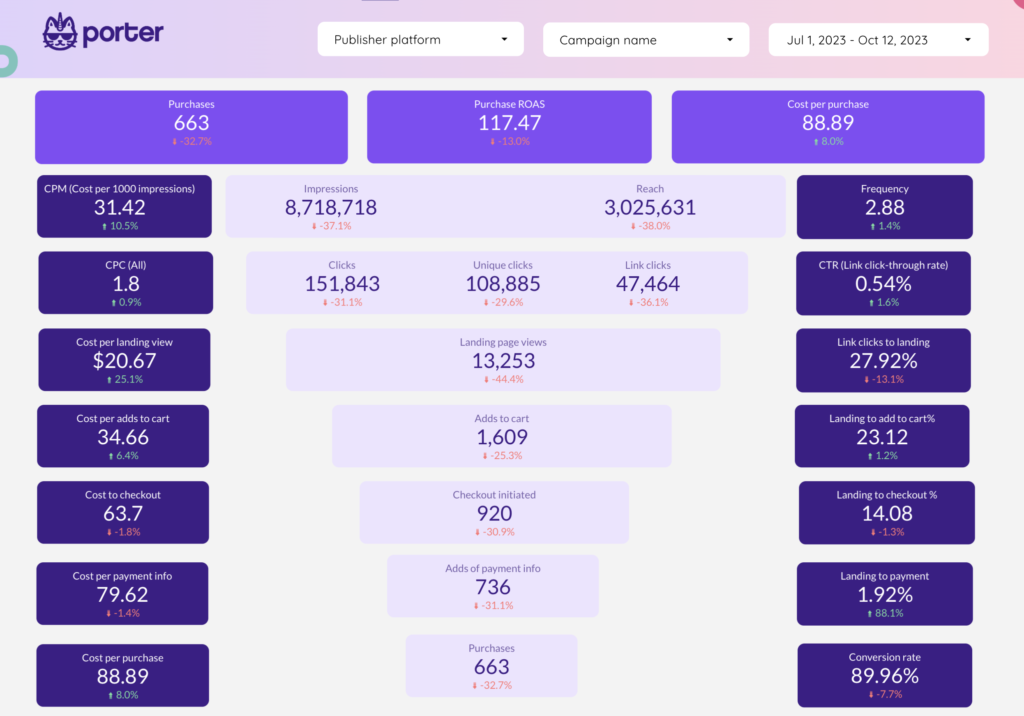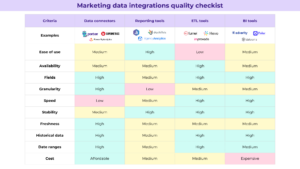Some Funnel alternatives include Porter Metrics, Supermetrics, Windsor AI, Power My Analytics, Polar Analytics, Dataslayer, and AgencyAnalytics.
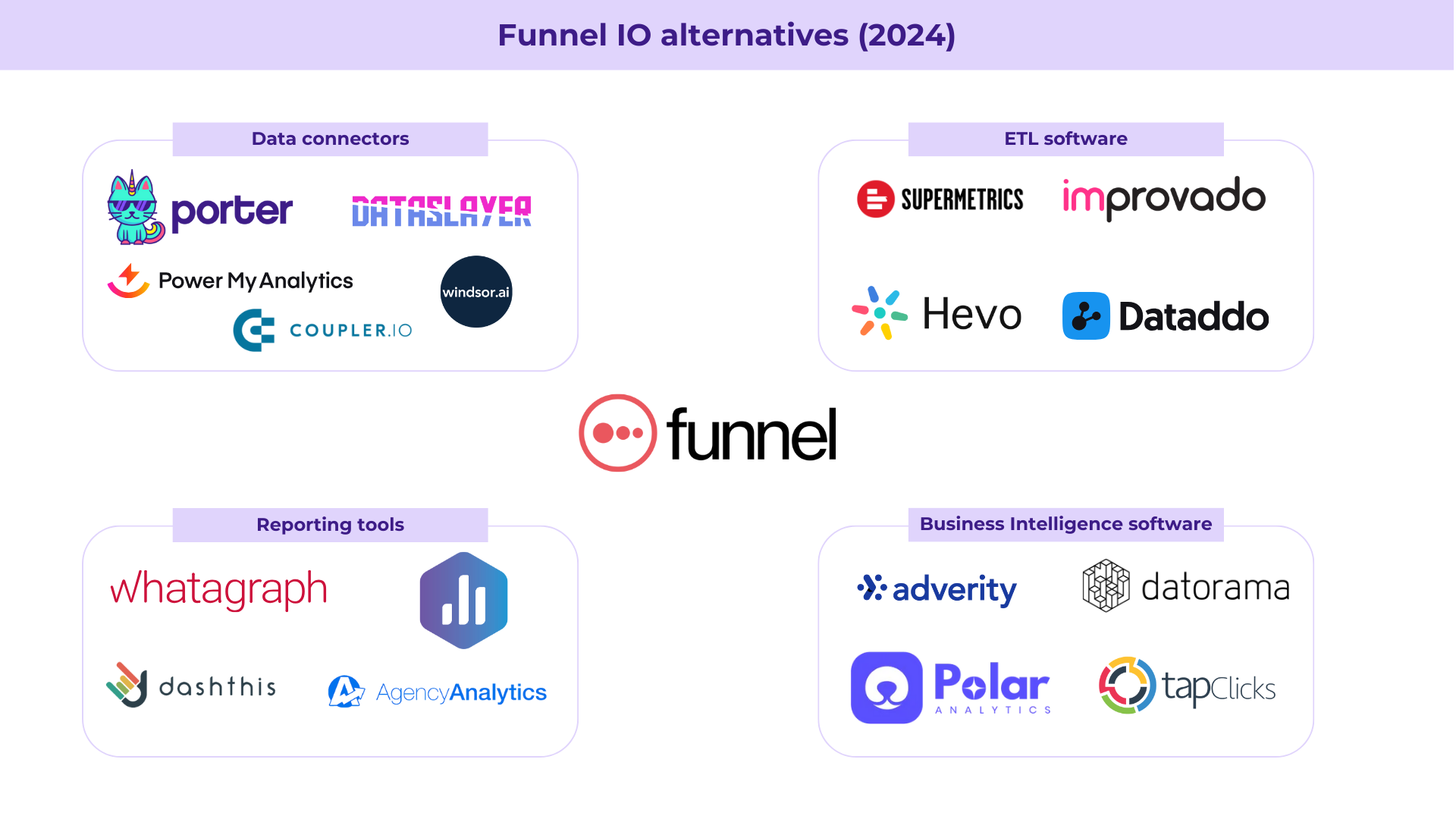
The best Funnel alternatives to try
- Porter Metrics for medium-sized marketing teams and agencies.
- Windsor AI if you are looking for a marketing attribution solution.
- Power My Analytics data warehouse and data connectors.
- DataSlayer for affordable and lower usage reporting due to API limits.
- Agency Analytics for marketing agencies needing robust client management.
- Polar Analytics reporting tool for ecommerce brands running on Shopify.
- Supermetrics for marketing teams and agencies that want advanced analytics capabilities.
Funnel alternatives comparison at a glance
Funnel alternatives feature comparison
| Comparison criteria | Supermetrics | Agency Analytics | Dataslayer | Windsor AI | Power My Analytics | Funnel | Porter Metrics | Polar Analytics |
|---|---|---|---|---|---|---|---|---|
| Data Sources | 200+ | 80+ | 45+ | 200+ | 45 | 500 | 18 | 45 |
| Data sources included in their first plan tier | “Only 4 data sources: Facebook Ads, Google Analytics 4, and Google Ads ⛔️” | All data sources (80+) ✅ | All data sources (45+) ✅ | All data sources (100+) ✅ | All data sources (45+) ✅ | All data sources (230+) ✅ | All data sources included (19+) ✅ | |
| Refresh time frequency | “Hourly, Daily, Weekly ✅” | Daily ✅ | “Daily, with API limits ⛔️” | Daily or hourly ✅ | Daily ✅ | Daily or every 2 hours ✅ | Daily or every 12 hours ✅ | Daily ✅ |
| Refresh time frequency for their first plan tier | Weekly ⛔️ | Daily ✅ | “Daily, with API limits ⛔️” | Daily ✅ | Daily ✅ | Daily ✅ | Daily ✅ | Daily ✅ |
| Report templates | Yes ✅ | Yes ✅ | Yes ✅ | Yes ✅ | Yes ✅ | Yes ✅ | Yes ✅ | Yes ✅ |
| Destinations | 16 | 4 | 13 | 8 | 20+ | 2 | 2 | |
| Starting price | $37/mo | 60/mo | 35/mo | 23/mo | “14,9/mo” | 1100/mo | “14,99/mo” | 300/mo |
| Free trials | Yes✅ | Yes✅ | Yes✅ | Yes✅ | Yes✅ | Yes✅ | Yes✅ | Yes✅ |
| Pricing model | “Based on data sources, user seats, destinations” | Per-client campaign pricing | Usage-based | Based on usage | Based on usage | Usage-based “Flexpoints” | Based on # of accounts connected | Based on order volume |
| Users access | Limited users per plan ⛔️ | Limited users per plan ⛔️ | Limited users per plan ⛔️ | Unlimited users and admins ✅ | Limited users per plan ⛔️ | Limited users per plan ⛔️ | Unlimited users and admins ✅ | Unlimited users and admins ✅ |
| User reviews on G2Crowd | 4.5 | “4,7” | “4,8” | “4,8” | “4,4” | “4,5” | “4,5” | 5 |
| Drawbacks | “Complex pricing, slow/unstable data without paid storage” | Limited data flexibility vs. ETL tools | Unpredictable pricing for high volumes | Some technical skills required | Limited transformation options | “High learning curve, expensive pricing” | Limited integrations compared to competitors | Less flexible than modular tools |
Funnel alternatives pricing comparison
Pricing of Funnel.io alternatives vary a lot. We’ve compiled their listed monthly plans, but remember, pricing models differ. For example, Porter Metrics bills per connected account, while others bill per “flexpoints”. Most offer trials and some have freemium plans.
TL;DR:
If you’re looking for a budget-friendly Funnel.io alternative for your marketing team or agency, Porter Metrics, Windsor AI, and Power My Analytics are the best choices for balancing features and budget.
AgencyAnalytics might seem better in price at first sight, but the reality is that their pricing per “client campaign” might affect your experience as a user because if you exceed the quotas, your costs will escalate quickly.
And definitely, if you are looking for more advanced features and integrations for larger e-commerce brands, Polar Analytics is worth the extra cost.
| Provider | Starting Price | Mid Plan | Highest Price | Average Price | Pricing Unit | Service Type | Free Plans |
|---|---|---|---|---|---|---|---|
| Porter Metrics | $15 | $40 | $180 | $78 | Accounts | Self-Service | 14-day free trial |
| Supermetrics | $37 | $299 | $724 | $370 | Data Sources | Self-Service | 14-day free trial |
| Funnel | $120 | $1,100 | $2,500 | $1,240 | Flexpoints | Self-Service | Freemium |
| Windsor AI | $23 | $118 | $598 | $246 | Data Sources | Self-Service | Freemium |
| Power My Analytics | $15 | $40 | $295 | $117 | Data Sources | Self-Service | 14-day free trial |
| Dataslayer | $35 | $76 | $383 | $165 | API Calls | Self-Service | Freemium |
| AgencyAnalytics | $60 | $180 | $900 | $380 | Client Campaigns | Self-Service | 14-day free trial |
| Polar Analytics | $300 | $450 | $450 | $400 | Orders | Sales Call | No |
| Databox | $47 | $135 | $799 | $327 | Data Source Connections | Self-Service | Freemium |
| Whatagraph | $219 | $499 | $899 | $539 | Source Credits | Sales Call | 7-day free trial |
Generally, the cost of marketing data connectors falls between $15/mo and $200/mo, whereas reporting or ETL tools are priced from $300/mo to $2,000/mo.
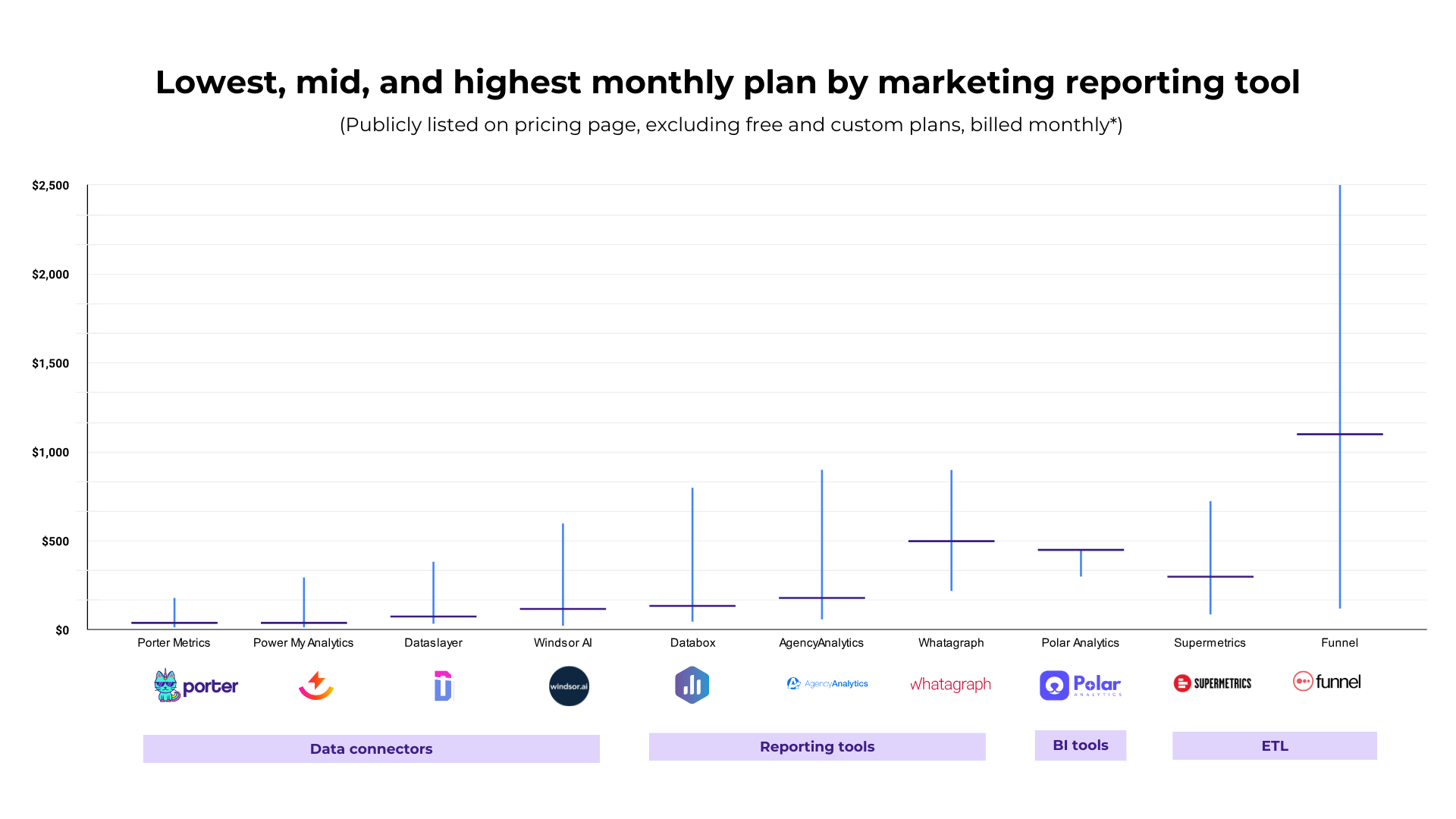
Consider these aspects to compare pricing:
- Compliance and Security: Pay attention to crucial certifications like SOC 2 Type 2 and features like SSO sign-in.
- Service Type: Tools that involve sales or onboarding calls tend to be costlier (about $300/mo), while self-service tools are usually more affordable.
- Documentation and Resources: Having access to tutorials, templates, and comprehensive documentation can optimize your workflow.
- Support and Training: Assess the availability of support, communication channels (chat, email, phone), and the provision of custom training and reporting services.
- Segment: SMBs often prioritize quick setup, ease of use, and flexible, affordable pricing, while enterprises value compliance and security features.
Criteria to choose a Funnel alternative
Chiefmartech says there are over 200 marketing analytics solutions, and most also offer marketing reporting automation and data management features, so finding actual alternatives to Funnel.io is tough.
I’ll share my perspective as a marketing analytics tech founder and Funnel.io competitor. You might expect me to favour Porter, but I dive deep into all reporting tools, considering their features and limitations that only become clear after you use them.
I created a framework to help you evaluate and choose a Funnel.io alternative and a marketing reporting tool that evaluates:
Features
- Data integrations – assess quality, ease of use, availability, speed, fields, granularity, stability, accuracy, freshness, historical data access, and date range flexibility.
- Data transformation – look for data normalization, blending, filtering, custom metrics, custom dimensions, and rule-based custom values for complex reporting.
- Destinations – consider options like vertical reporting tools, spreadsheets, data visualization platforms, and data warehouses for reporting, visualization, and automation.
Solution types
Understand the strengths of different marketing analytics software categories:
- Built-in analytics
- Data connectors
- Data visualization tools
- Vertical reporting tools
- Tracking solutions
- Business intelligence platforms
- ETL solutions
- Attribution software
Integrations
When comparing integrations of Funnel alternatives, assess criteria such as ease of use, availability, speed, granularity, field, stability, and accuracy.
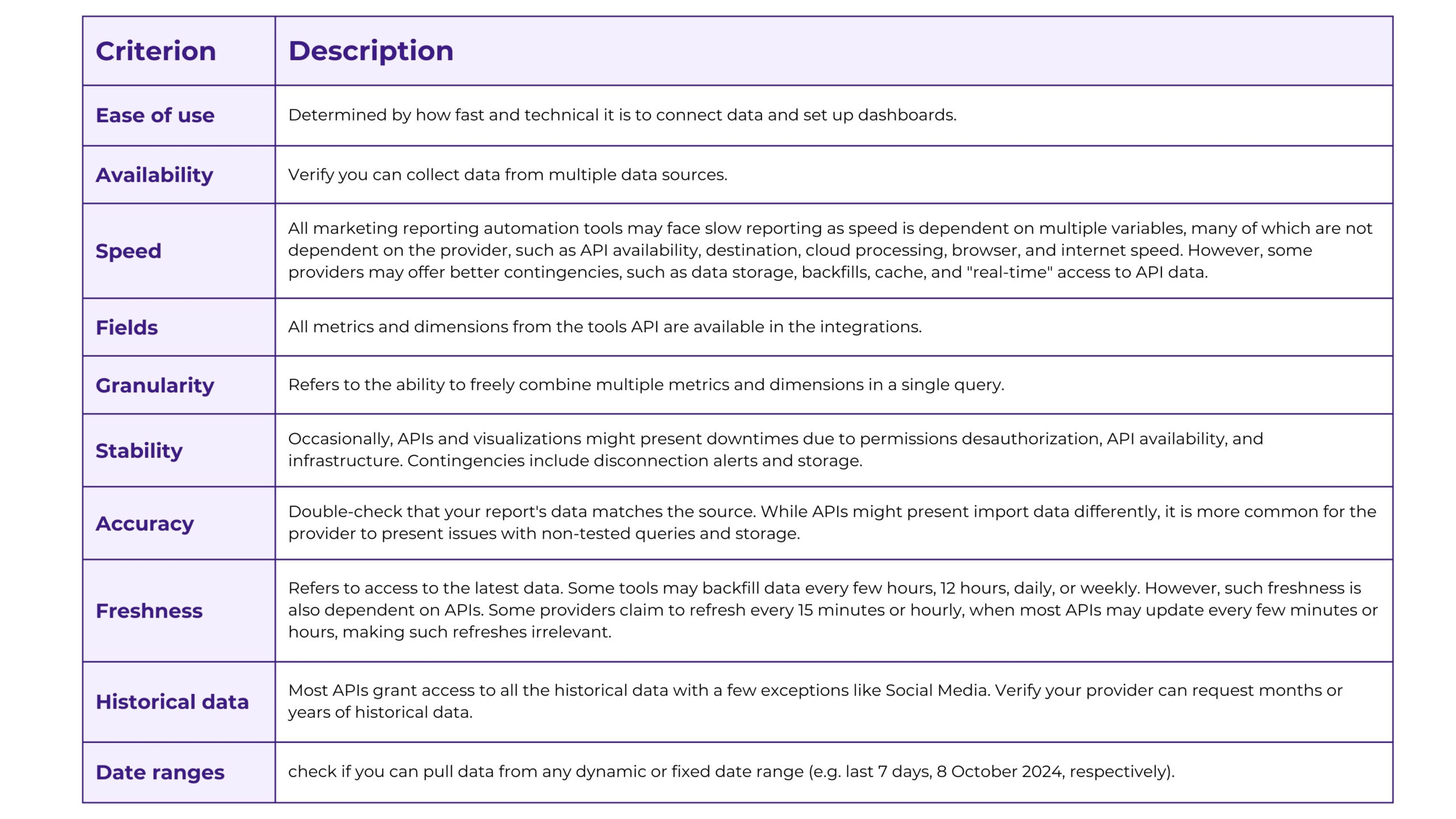
Pricing
- Plans and models – compare pricing plans, models, and average costs of different providers.
- Additional factors – consider compliance, security, service type (self-service vs. sales calls), documentation, resources, support, and training beyond just the numbers.
Other considerations
- User management – check the number of users allowed and costs for additional users.
- Drawbacks – be aware of limitations like limited integrations, complex pricing, high learning curves, or lack of flexibility.
- Ease of use – evaluate the learning curve and user-friendliness.
- Templates – look for pre-built templates to quickly test and implement the tool.
Best Funnel alternatives detailed comparison
Porter Metrics
Porter Metrics is a no-code marketing reporting tool to measure marketing performance towards bottom-line, revenue and profit metrics with no data warehouses, scripts, or additional tools required, across all your marketing channels, products, clients, and campaigns.It connects to the most popular B2B and e-commerce marketing data for small businesses such as Shopify, HubSpot, GA4, Facebook Ads, and Instagram, to destinations like Looker Studio (formerly Data Studio) and GoogleSheets.
+100 Looker Studio templates and +100 Youtube tutorials on marketing reporting. Used by +1,500 marketing teams in 60 countries.
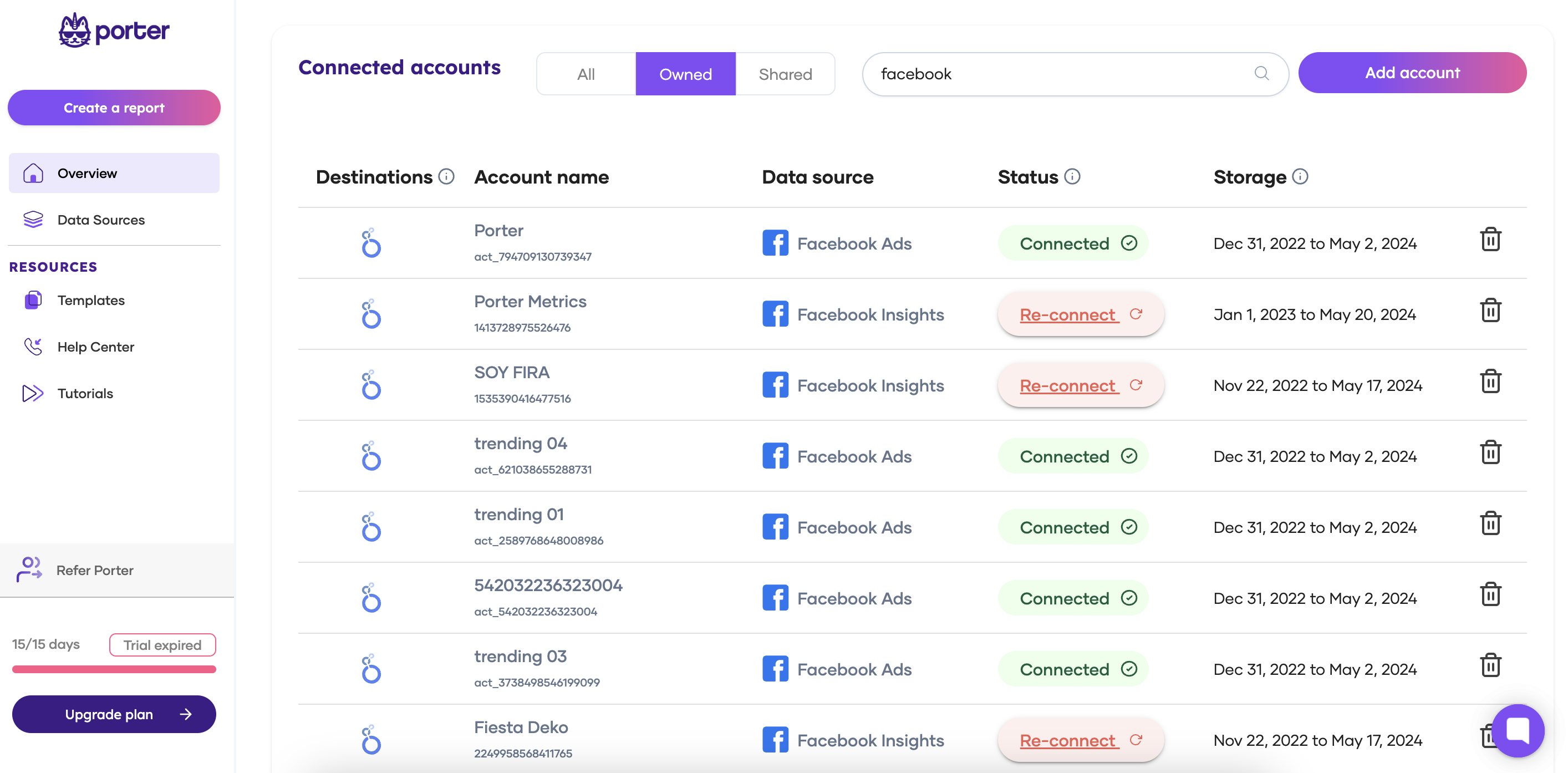
Porter Metrics vs.Funnel detailed comparison
| Comparison criteria | Data Sources | Data sources included in their first plan tier | Refresh time frequency | Refresh time frequency for their first plan tier | Report templates | Destinations | Starting price | Free trials | Pricing model | Users access | User reviews on G2Crowd | Drawbacks |
|---|---|---|---|---|---|---|---|---|---|---|---|---|
| Funnel | 500 | All data sources (230+) ✅ | Daily or every 2 hours ✅ | Daily ✅ | Yes ✅ | 20+ | 1100/mo | Yes✅ | Usage-based “Flexpoints” | Limited users per plan ⛔️ | 4,5 | High learning curve, expensive pricing |
| Porter Metrics | 18 | All data sources included (19+) ✅ | Daily or every 12 hours ✅ | Daily ✅ | Yes ✅ | 2 | 14,99/mo | Yes✅ | Based on # of accounts connected | Unlimited users and admins ✅ | 4,5 | Limited integrations compared to competitors |
Porter Metrics pricing
Simple, flat pricing based solely on the number of connected accounts across various marketing platforms. Plans range from $14.99/month for 1 account to $180/month for 40 accounts. All plans include unlimited users, data destinations (Looker Studio, Sheets), integrations, with no additional usage fees.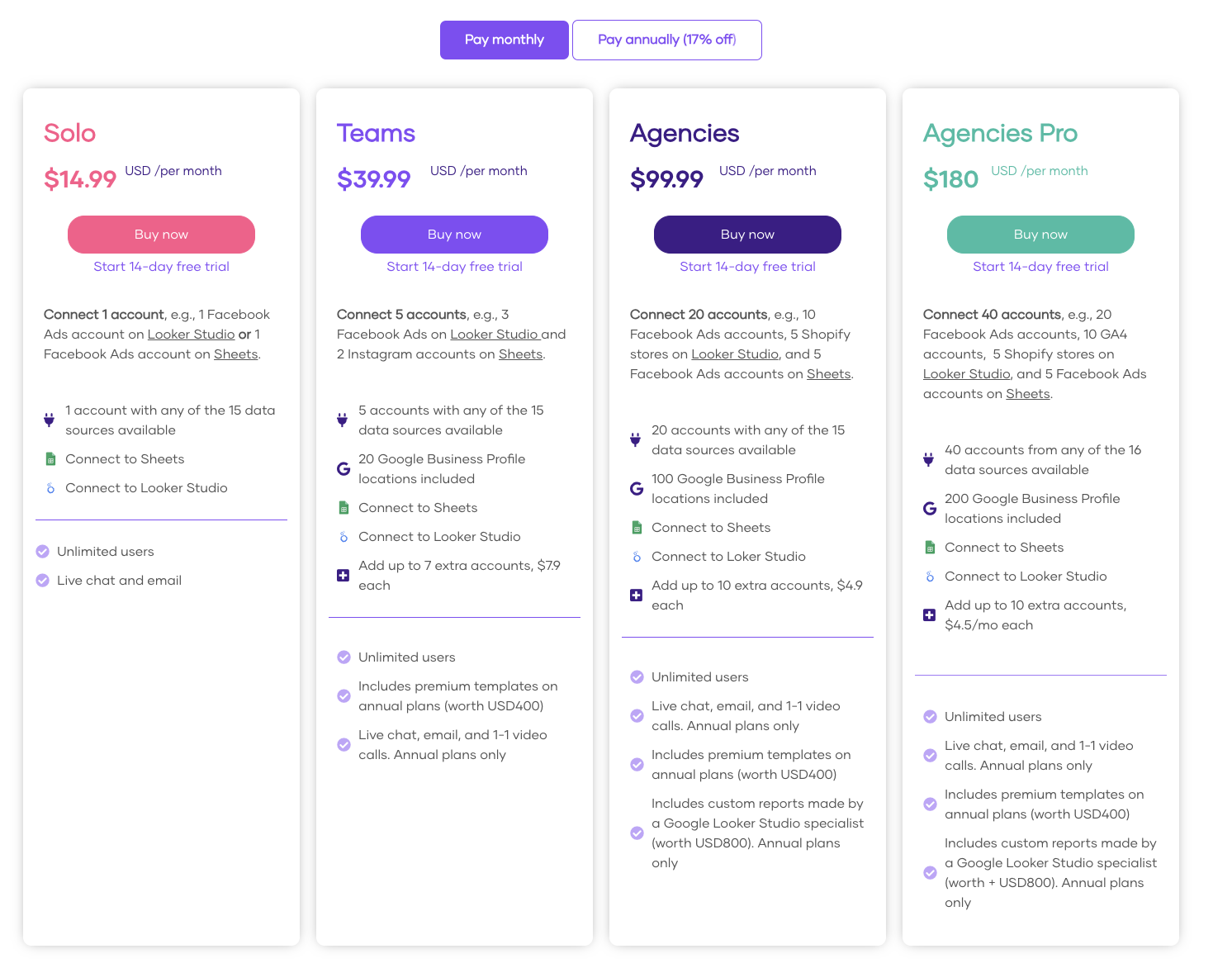
Porter Metrics provides an easy-to-use, no-code solution with plenty of templates and tutorials, perfect for medium-sized marketing teams and agencies that need simplicity and efficiency without the technical complexity.
Funnel.io, while offering powerful data transformation capabilities and extensive integrations, requires a high level of technical proficiency, making it best suited for technical marketing teams and data analysts. Funnel.io’s pricing model is based on Flexpoints, which can quickly become expensive due to multiple connections for the same data source and the inclusion of various tables or endpoints.
One of the biggest differences between Porter Metrics and Funnel.io is that Porter Metrics offers more templates and allows you to connect all the data from a single connector with a single integration. In contrast, Funnel.io requires you to choose specific tables and data for export, making it more suited for technical marketers or teams with specific data transformation needs.
Pros of choosing Porter Metrics as a Funnel alternative
- No-code reporting tool connects to 19+ data sources, including Shopify, HubSpot, Facebook Ads, GA4, Instagram
- Self-managed BigQuery data storage for accurate, stable, fast reporting
- 100+ free Looker Studio report templates and 100+ YouTube tutorials
- Free 1:1 customer support via chat, email, and calls in English and Spanish
- Simple, flexible pricing based on accounts connected; unlimited users, reports, usage
Cons of choosing Porter Metrics as a Funnel alternative”
The following are reasons to seek Porter Metrics alternatives.
- Fewer connectors (19+) than some alternatives; focuses on SMBs, agencies, e-commerce, lead gen
- No built-in data transformation features; requires Looker Studio or Sheets for blending, segmentation, custom fields
- Not suitable for large enterprises requiring sales CRM and database integrations (e.g., Salesforce, Adobe)
- May not be appropriate if finding Looker Studio or Sheets too complex for basic reporting needs
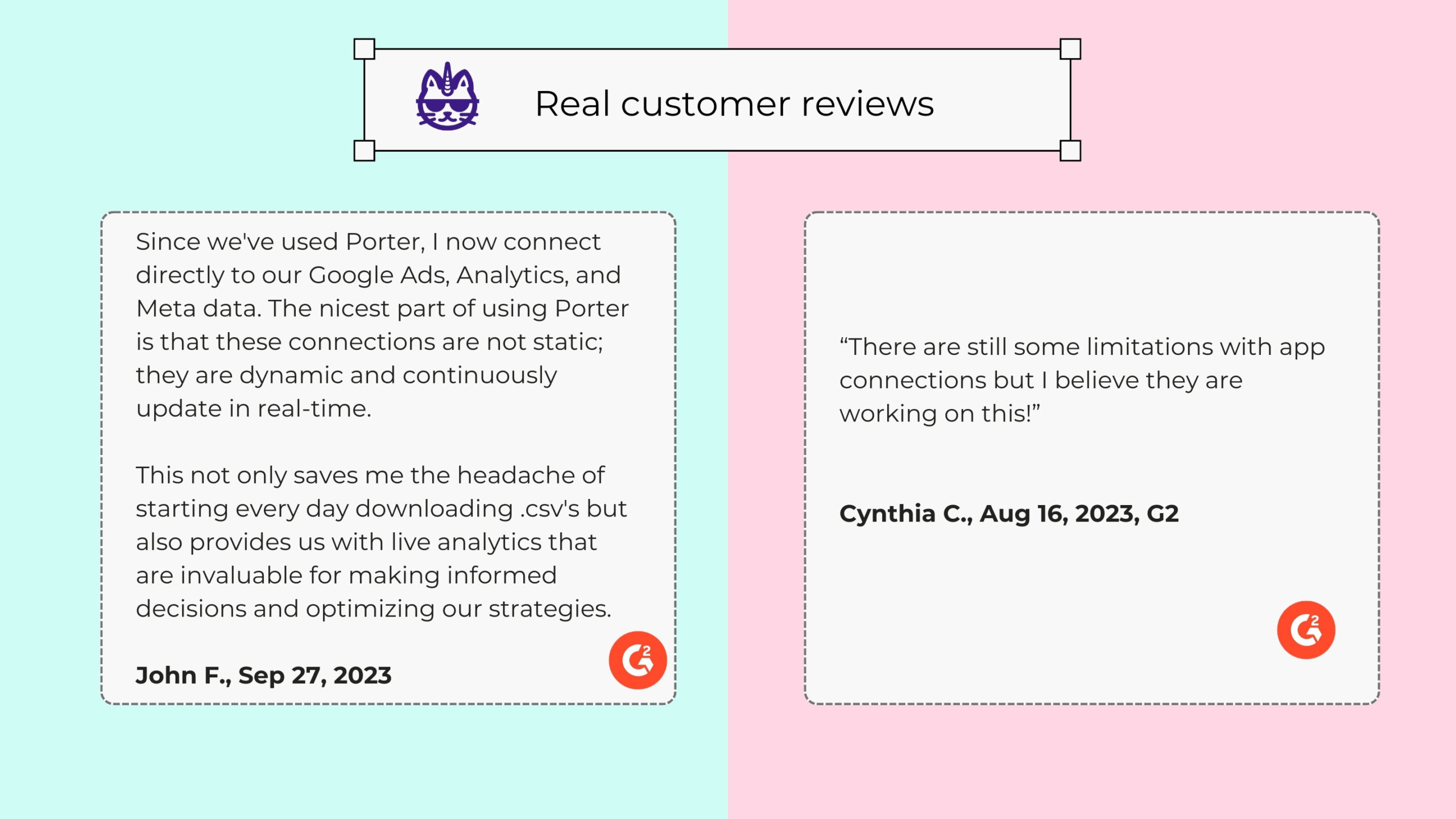
Supermetrics
Supermetrics is a data integration and reporting tool for marketing and sales data. With 200+ integrations for e-commerce, B2B, ads, sales data, Supermetrics is an established market leader with 17,000+ customers, tracks 10%+ global ad spend.Supermetrics collects data from sources like CRMs, analytics tools, and ad platforms, then loads it directly into the destinations teams already use – spreadsheets, visualization tools, data warehouses.

Funnel vs.Supermetrics detailed comparison
| Comparison criteria | Data Sources | Data sources included in their first plan tier | Refresh time frequency | Refresh time frequency for their first plan tier | Report templates | Destinations | Starting price | Free trials | Pricing model | Users access | User reviews on G2Crowd | Drawbacks |
|---|---|---|---|---|---|---|---|---|---|---|---|---|
| Funnel | 500 | All data sources (230+) ✅ | Daily or every 2 hours ✅ | Daily ✅ | Yes ✅ | 20+ | 1100/mo | Yes✅ | Usage-based “Flexpoints” | Limited users per plan ⛔️ | 4,5 | High learning curve, expensive pricing |
| Supermetrics | 200+ | Only 4 data sources: Facebook Ads, Google Analytics 4, and Google Ads ⛔️ | Hourly, Daily, Weekly ✅ | Weekly ⛔️ | Yes ✅ | 16 | $37/mo | Yes✅ | Based on data sources, user seats, destinations | Limited users per plan ⛔️ | 4.5 | Complex pricing, slow/unstable data without paid storage |
Supermetrics pricing
Supermetrics pricing is based on number of integrations, accounts per data source, and destinations. Higher tiers unlock more integrations, while agencies may need custom plans for additional accounts. Pricing varies across destinations, with spreadsheets and Looker Studio being more affordable compared to Power BI and data warehouses.Plans range from $37/month for the Essential plan with 1 user and 11 data sources, up to $724/month for the Super plan with 1 user and 82 sources. Enterprise custom pricing is available for unlimited users and 119 sources.
Additional costs include $87-$724 per extra user and $24 per additional data source. All plans include automated data refreshes and connectors.
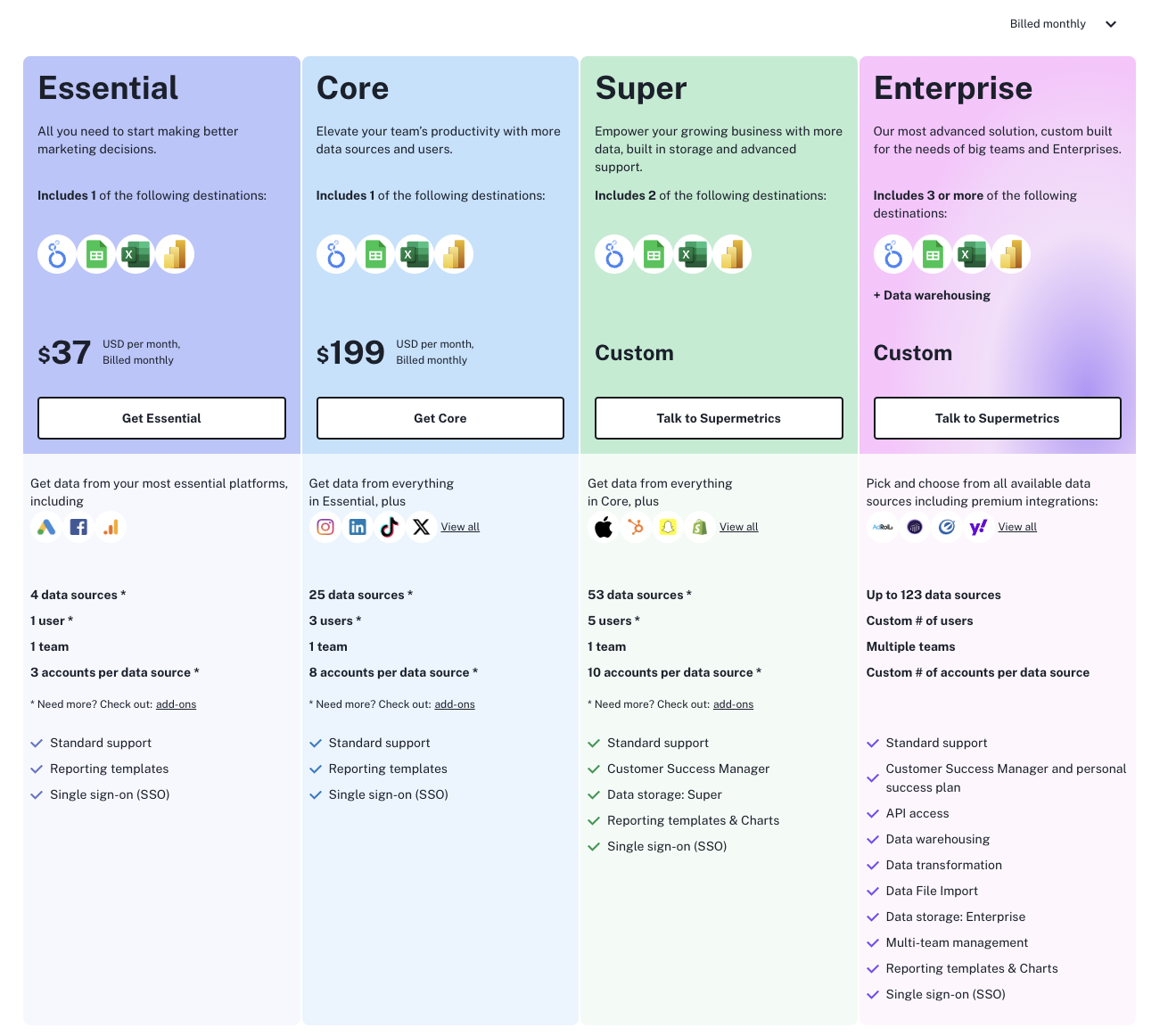
Who is Power My Analytics best for?
Supermetrics is ideal for marketing teams needing extensive data connectors, advanced data transformation capabilities, and support for various destinations, including data warehouses and BI tools. Its ability to handle complex data transformations and support multiple destinations makes it suitable for companies that require robust data integration solutions.
Funnel.io is an excellent choice for data teams in mid-market and enterprise companies who need powerful data transformation capabilities and built-in data warehousing. It is best suited for technical marketing teams and data analysts who can leverage its advanced features.
Pros of choosing Supermetrics as a Funnel alternative
- 200+ integrations including Salesforce, Shopify, Facebook Ads, Google Analytics
- Data destinations: Google Sheets, Excel, Looker Studio, BigQuery, Snowflake
- Data transformation feature, built-in storage, and APIs allow companies to create custom fields to calculate CPAs, run reports faster, and store data in their own databases
- Multilanguage field translation for users
Cons of choosing Supermetrics over Funnel
The following are reasons to look for Supermetrics alternatives.
- Complex, inflexible and expensive pricing based on number of data sources, accounts per data source, users, data sources available only on certain plans, and destination
- Data transformation features, built-in storage, and APIs are only available in enterprise plans
- “Canned answers” and slow, rigid email/chat support reported by users
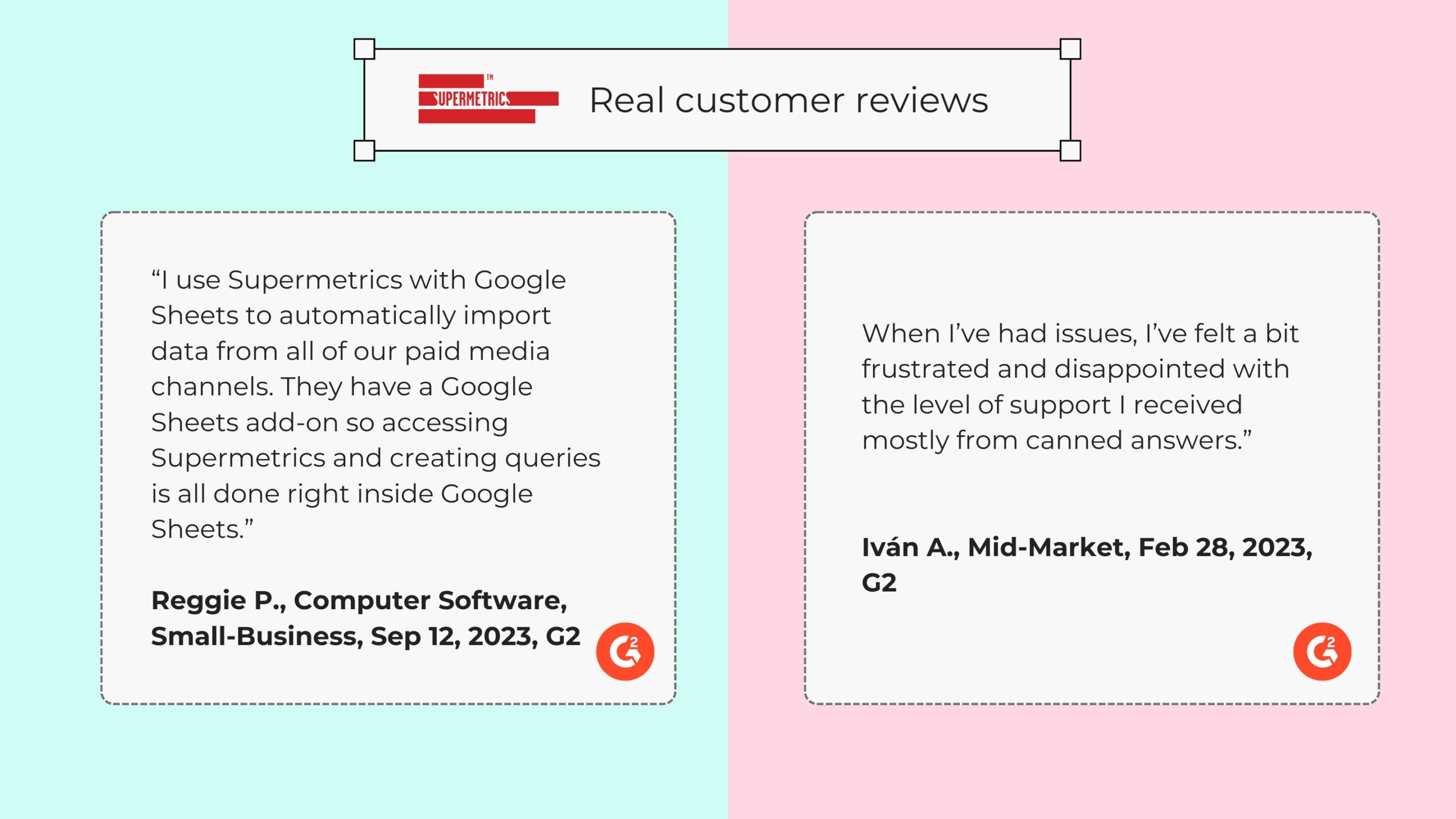
Windsor AI
Windsor is an ETL tool and marketing attribution software. Since 2019, it has developed over 300 integrations for data collection and data pipelines, built for technical marketers and data analysts.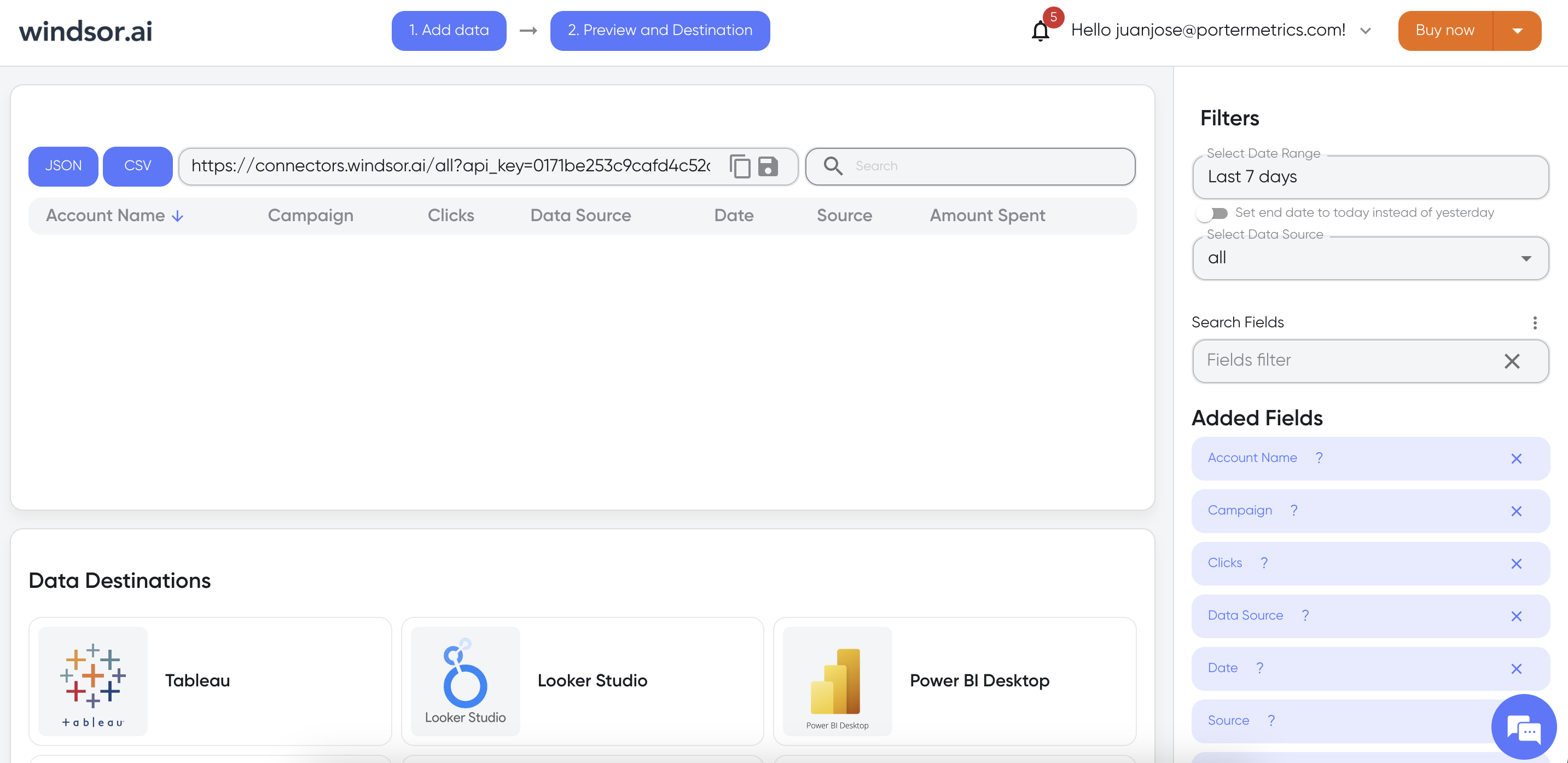
Funnel vs. Windsor AI detailed comparison
| Comparison criteria | Data Sources | Data sources included in their first plan tier | Refresh time frequency | Refresh time frequency for their first plan tier | Report templates | Destinations | Starting price | Free trials | Pricing model | Users access | User reviews on G2Crowd | Drawbacks |
|---|---|---|---|---|---|---|---|---|---|---|---|---|
| Funnel | 500 | All data sources (230+) ✅ | Daily or every 2 hours ✅ | Daily ✅ | Yes ✅ | 20+ | 1100/mo | Yes✅ | Usage-based “Flexpoints” | Limited users per plan ⛔️ | 4,5 | High learning curve, expensive pricing |
| Windsor AI | 200+ | All data sources (100+) ✅ | Daily or hourly ✅ | Daily ✅ | Yes ✅ | 13 | 23/mo | Yes✅ | Based on usage | Unlimited users and admins ✅ | 4,8 | Some technical skills required |
Windsor AI pricing
Flexible pricing model ranging from a free plan to $598/month Professional plan. Pricing is determined by the number of data sources (1-14), connected accounts (1-500 accounts), and additional enterprise features like invoicing and SLAs. Unlimited users and destinations included.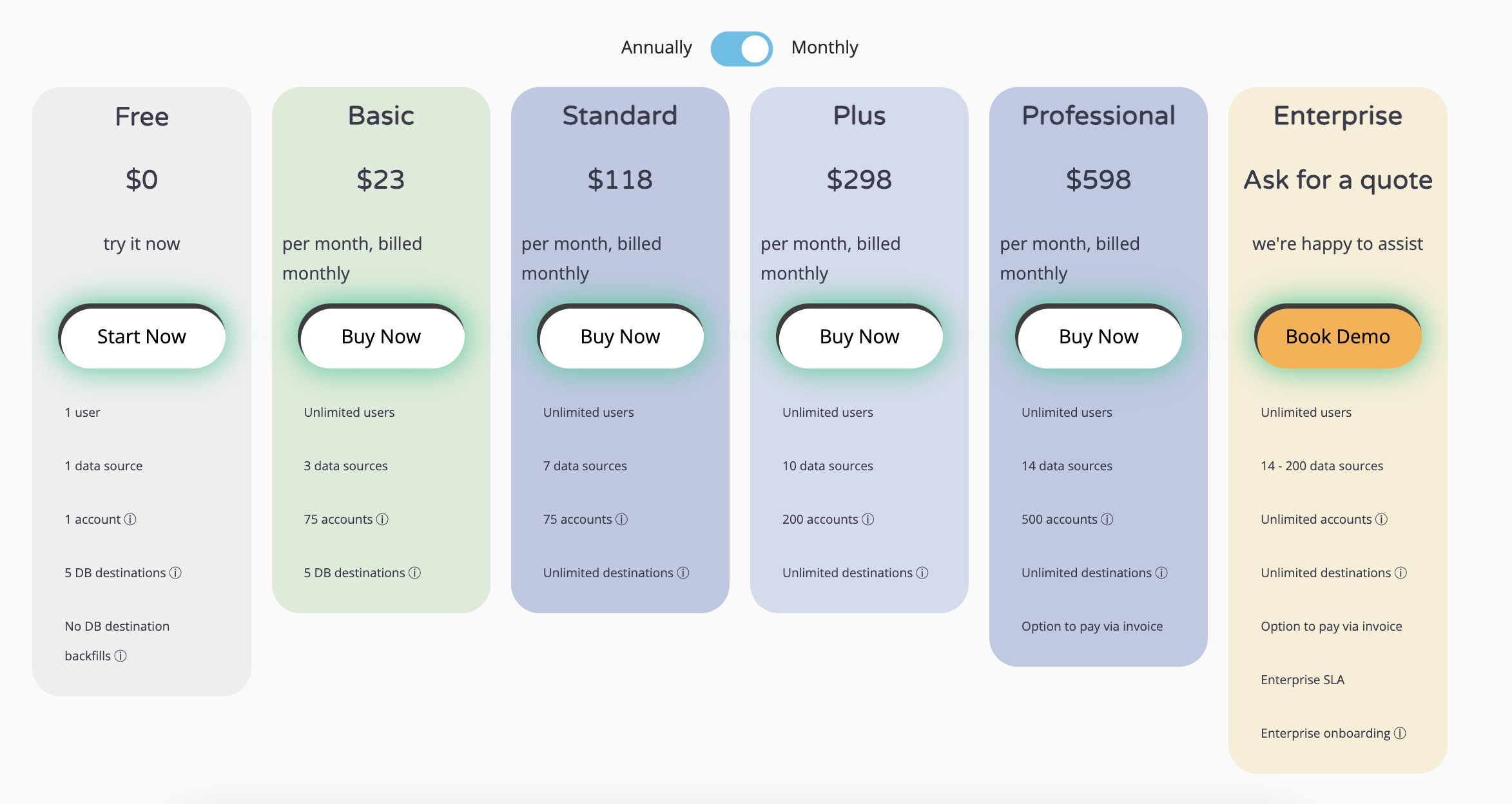
Who is Windsor AI best for?
Windsor.ai excels in multi-touch attribution, offering detailed insights into how different marketing channels contribute to conversions. This is ideal for businesses that need to optimize their marketing spend based on comprehensive attribution data.
However, Funnel.io provides more data sources, data transformation capabilities, and data blending options, making it suitable for technical marketing teams and data analysts who require robust data handling and built-in data warehousing.
Pros of choosing Windsor AI as a Funnel alternative
- 200+ Integrations: Google Analytics, Salesforce, HubSpot, Facebook Ads, Shopify
- Affordable, flexible pricing based on the number of data sources, accounts, and destinations connected
- Combines data across platforms for ROAS/CAC reporting by channel, campaign, creative, cohort for optimization
- Users cite fast support and responsiveness from founders to guide implementation
Cons of choosing Windsor AI over Funnel
The following are reasons to look for Windsor AI alternatives.
- Metrics differ from native platforms; tricky to find; needs better documentation
- Challenging for marketers expecting plug-and-play; not intuitive for non-technical users expecting Looker Studio simplicity
- If you have multiple data sources (5+), their pricing becomes less efficient as they offer multiple accounts from the same data source
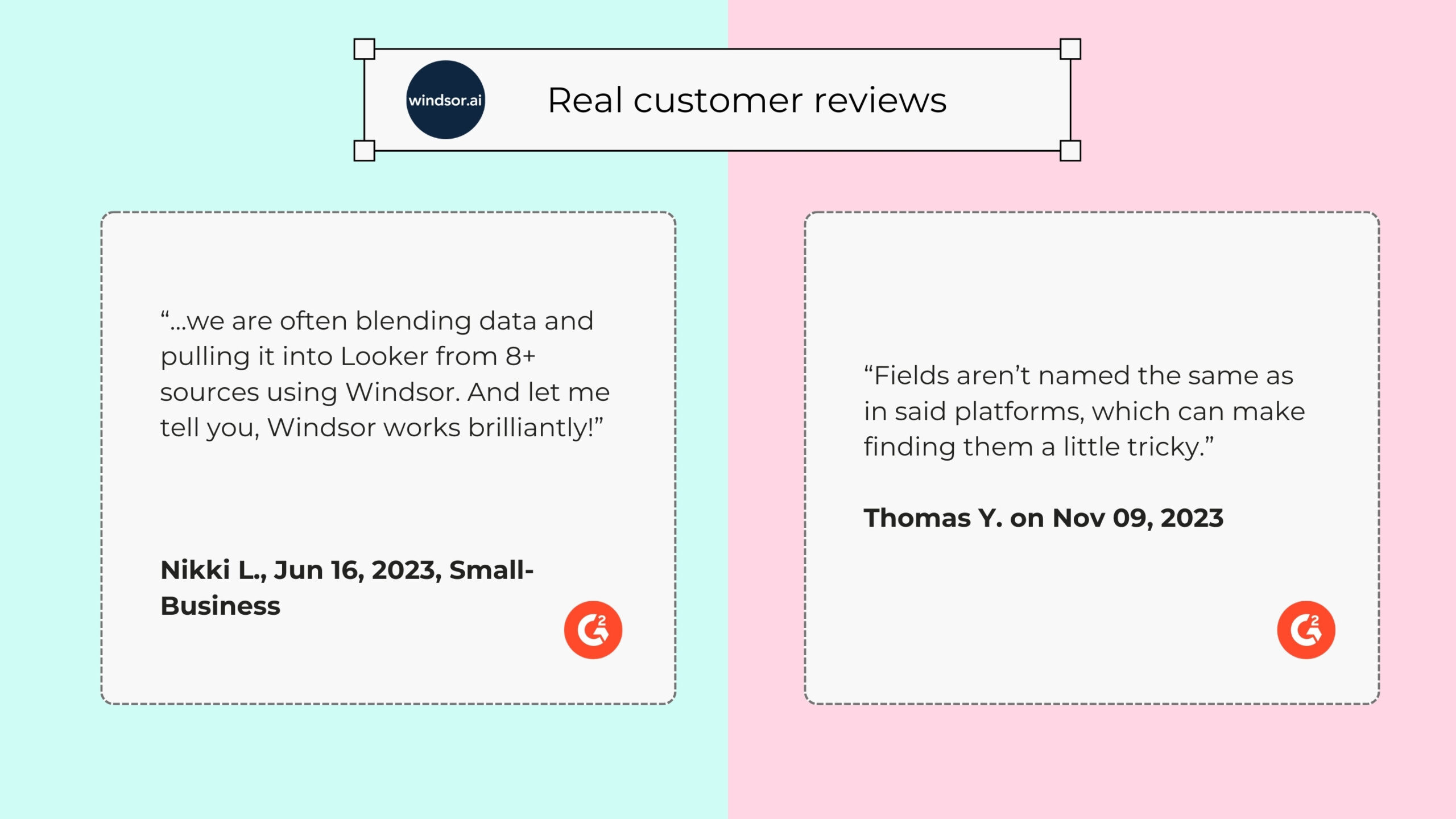
Power My Analytics
Power My Analytics is a no-code ETL tool offering direct marketing data source integrations to destinations like Looker Studio, Sheets, Analytics, Excel, BigQuery, and its API. At Porter Metrics, we benchmark it favorably for quality, customer satisfaction, and reliability.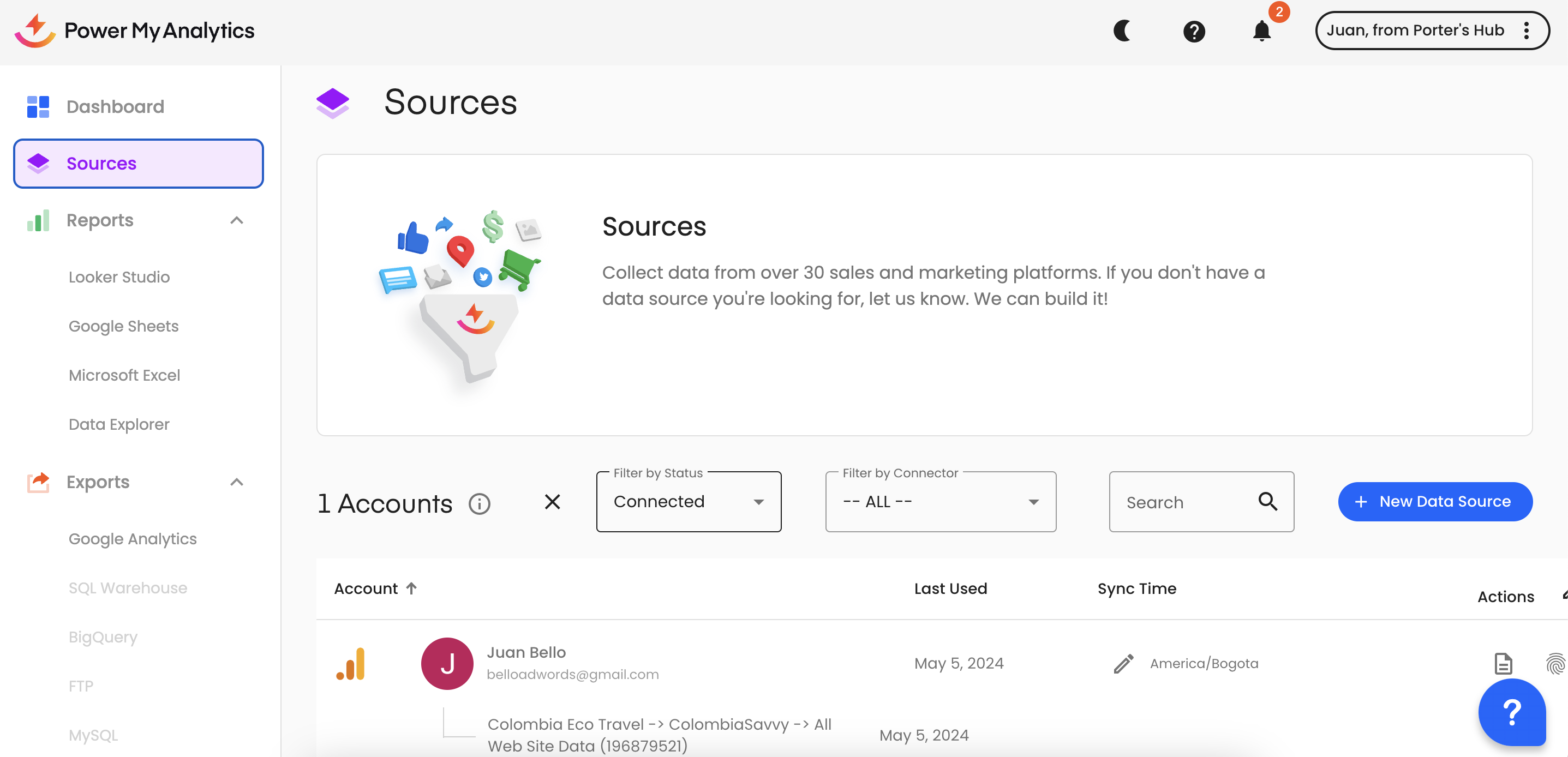
Funnel vs. Power My Analytics detailed comparison
| Comparison criteria | Data Sources | Data sources included in their first plan tier | Refresh time frequency | Refresh time frequency for their first plan tier | Report templates | Destinations | Starting price | Free trials | Pricing model | Users access | User reviews on G2Crowd | Drawbacks |
|---|---|---|---|---|---|---|---|---|---|---|---|---|
| Funnel | 500 | All data sources (230+) ✅ | Daily or every 2 hours ✅ | Daily ✅ | Yes ✅ | 20+ | 1100/mo | Yes✅ | Usage-based “Flexpoints” | Limited users per plan ⛔️ | 4,5 | High learning curve, expensive pricing |
| Power My Analytics | 45 | All data sources (45+) ✅ | Daily ✅ | Daily ✅ | Yes ✅ | 8 | 14,9/mo | Yes✅ | Based on usage | Limited users per plan ⛔️ | 4,4 | Limited transformation options |
Power My Analytics pricing
Starts at $14.95/month for 1 data source and 1 account. Scales up to $295/month for 40 sources, unlimited accounts per source, data warehousing, and 4+ admin users. Additional fees for Google Sheets ($50/month) and Google Business Profile integration.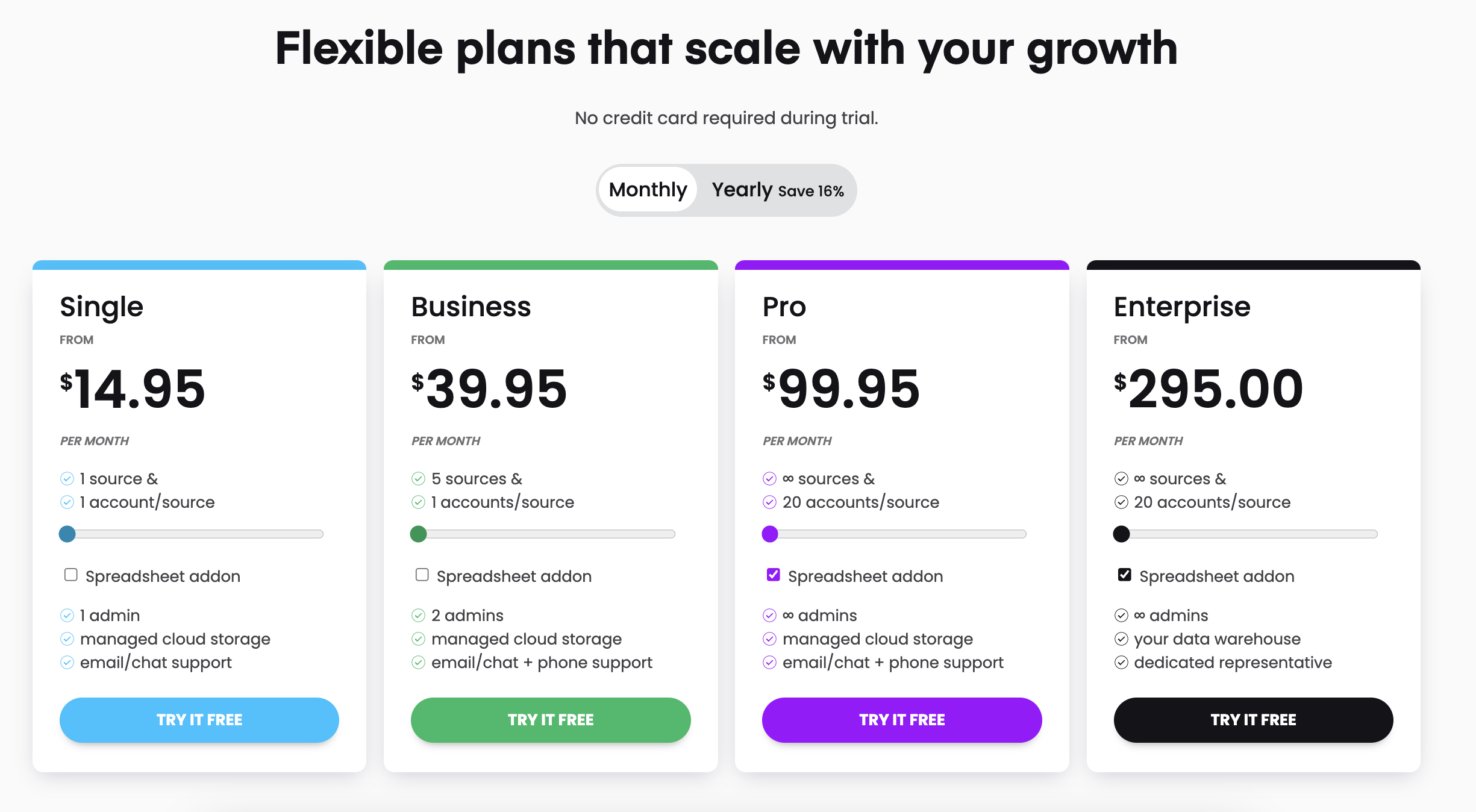
Who is Power My Analytics best for?
Power My Analytics offers a straightforward pricing model and is easy to use, making it a great option for teams that need a simple yet effective data reporting tool. It is particularly beneficial for PPC and e-commerce marketers who need granular data access and the ability to merge multiple ad accounts.
However, Funnel.io offers more data sources, data transformation capabilities, and data blending options. This makes it suitable for technical marketing teams and data analysts who need powerful data transformation capabilities and built-in data warehousing. Funnel.io’s Flexpoints system can become expensive due to multiple connections for the same data source and various tables or endpoints.
Pros of choosing Power My Analytics as a Funnel alternative
- Direct connector to Looker Studio, Sheets, Analytics, Excel, BigQuery, API
- Automatic storage: PMA backfills data into a cloud storage for fast, reliable integrations without needing additional warehouse setup
- Great customer support: Fast support, complete documentation, and the possibility to schedule free onboarding sessions
- Usually good performance in terms of report speed
Cons of choosing Power My Analytics over Funnel
The following are reasons to look for Power My Analytics alternatives.
- No built-in data transformation: Users need to send raw data to a destination to blend, clean, or calculate custom fields
- First-time users need help with possible dimensions/metrics and platform limitations
- Technical concepts like combining metrics/dimensions can be challenging for novice marketers
- Integrations don’t include all API fields; combining different data types from the same source can break reports
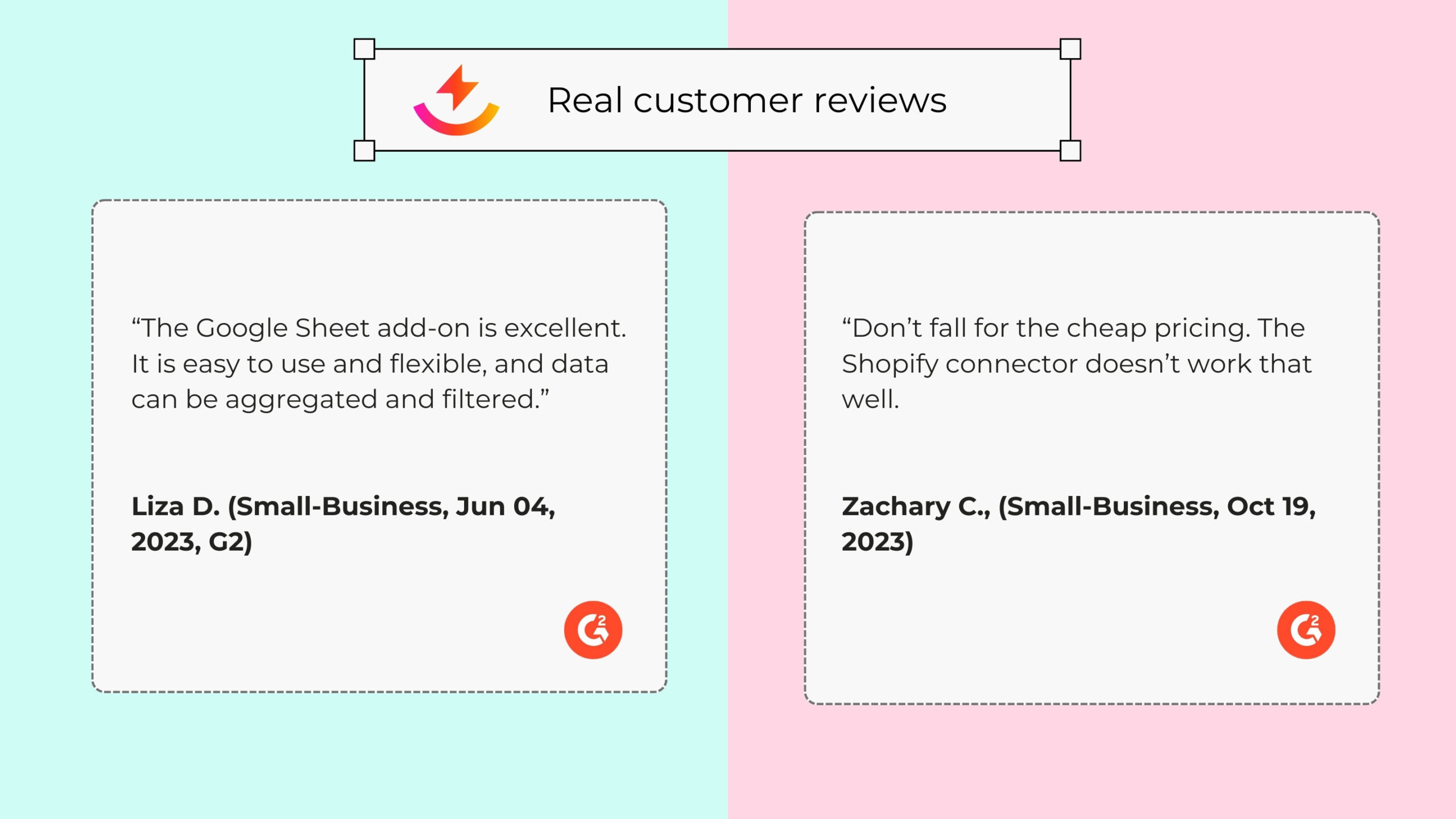
Polar Analytics
Polar Analytics is a no-code analytics and data integration platform for e-commerce Shopify brands with $2+ million annual revenue.All-in-one approach with custom dashboards, visualizations, integrations, conversion/attribution script, AI chat analysis, alerts, data transformation.
Automatically aggregates and combines channels to calculate CAC, LTV, retention, contribution margins, profits. Drawbacks: plans start $300/mo, not fully self-service, requires setup call.
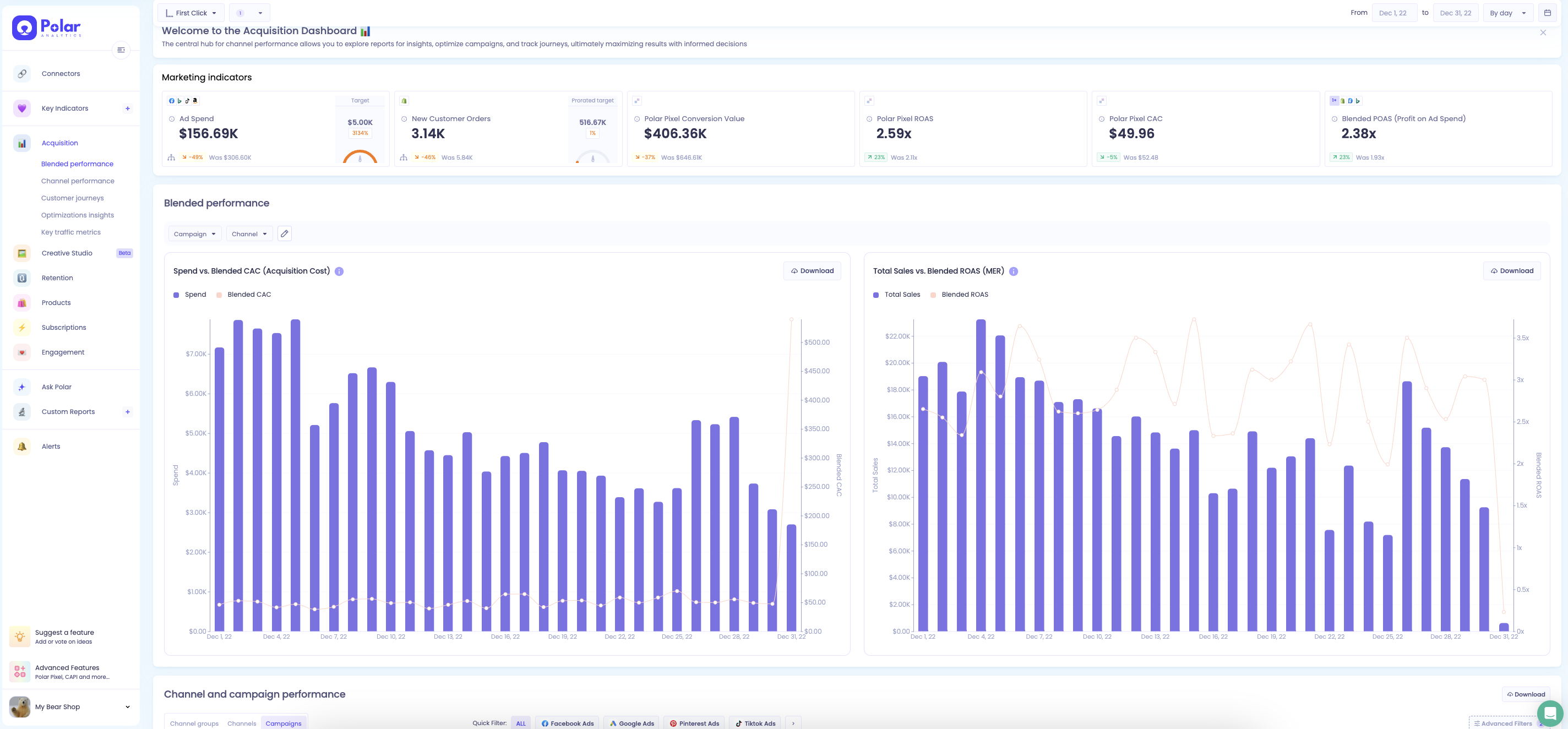
Funnel vs. Polar Analytics detailed comparison
| Comparison criteria | Data Sources | Data sources included in their first plan tier | Refresh time frequency | Refresh time frequency for their first plan tier | Report templates | Destinations | Starting price | Free trials | Pricing model | Users access | User reviews on G2Crowd | Drawbacks |
|---|---|---|---|---|---|---|---|---|---|---|---|---|
| Funnel | 500 | All data sources (230+) ✅ | Daily or every 2 hours ✅ | Daily ✅ | Yes ✅ | 20+ | 1100/mo | Yes✅ | Usage-based “Flexpoints” | Limited users per plan ⛔️ | 4,5 | High learning curve, expensive pricing |
| Polar Analytics | 45 | All data sources included (23+) ✅ | Daily ✅ | Daily ✅ | Yes ✅ | 2 | 300/mo | Yes✅ | Based on order volume | Unlimited users and admins ✅ | 5 | Less flexible than modular tools |
Polar Analytics pricing
Pricing is based on total tracked orders, starting at $300/month for 2,000 orders. Price per tracked order decreases with higher volumes, down to $0.04/order for over 50,000 orders per month. Enterprise plan pricing for companies over $20M GMV.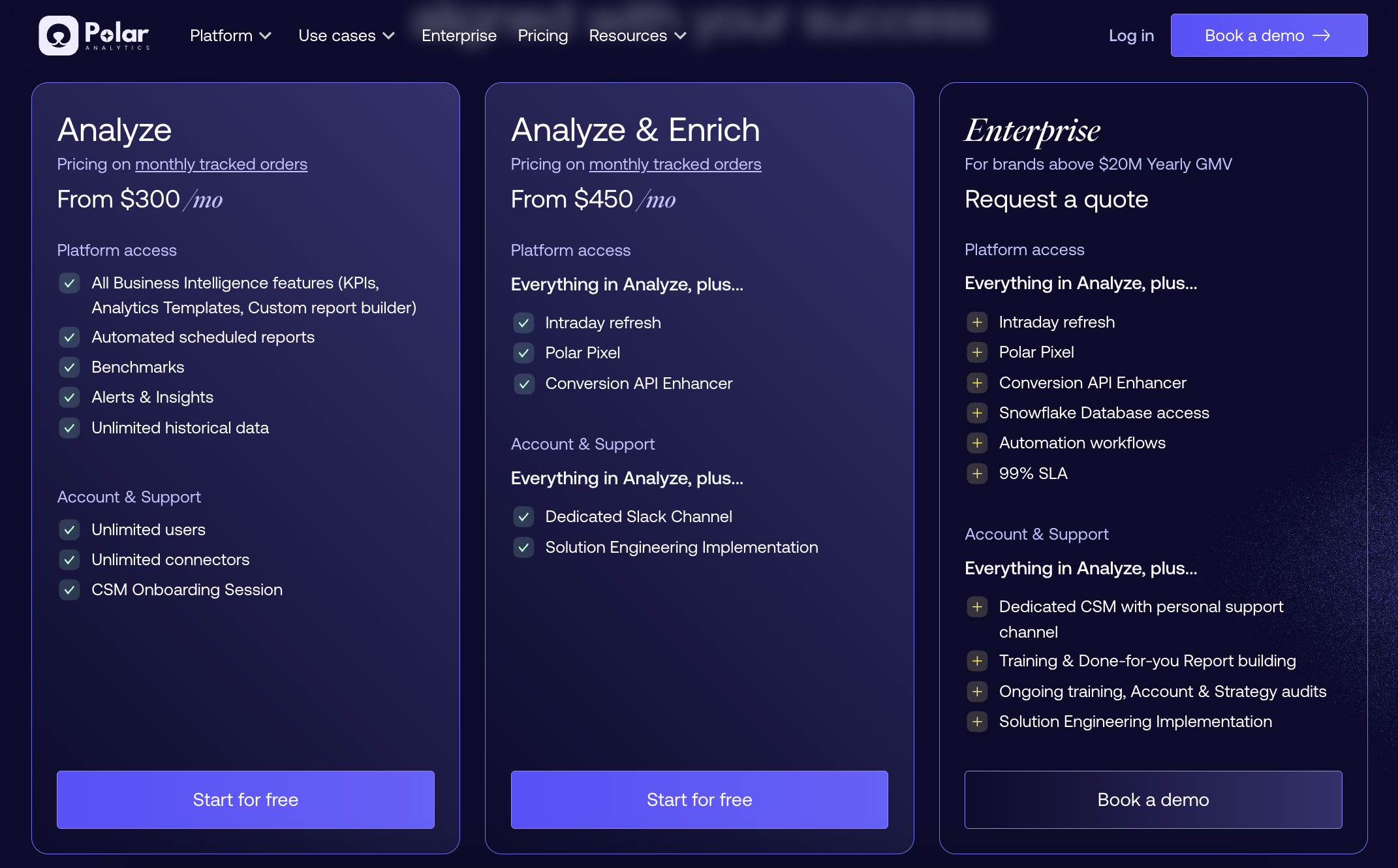
Who is Polar Analytics best for?
Funnel.io’s extensive data sources, transformation capabilities, and data blending options make it suitable for larger enterprises needing robust data handling solutions. Its ability to handle complex data transformations and support multiple connections for the same data source is a significant advantage.
Polar Analytics, however, is geared towards larger Shopify-based e-commerce brands and offers an all-in-one, no-code analytics and reporting solution. It automatically aggregates data from multiple marketing channels to calculate attribution and profit-based metrics, which is beneficial for e-commerce businesses needing a focused solution for marketing analytics.
Pros of choosing Polar Analytics as a Funnel alternative
- Pre-built Shopify dashboards: sales, profits, CAC, AOV by marketing channel, SKU
- Consolidates Facebook Ads, Google Analytics, Klaviyo, ReCharge data in one place
- Calculates key DTC metrics automatically: MER, CPC, ROAS, LTV by segment
- Stellar support: users cite daily outreach, hour-long calls, technical assistance
Cons of choosing Polar Analytics over Funnel
The following are reasons to look for Polar Analytics alternatives.
- Incomplete metrics and documentation: lacks some specific analyses and metrics needed by marketing teams and agencies, such as outbound clicks for Facebook Ads
- Slow, delayed data retrieval: runs daily backfills by default, useful for weekly/monthly monitoring but unfeasible for day-to-day or real-time analytics like ad pacing or Black Friday events
- Some users report occasional “slow” load times in reviews on G2 and Shopify
Dataslayer
Dataslayer is an affordable ETL tool built PPC marketers. It has garnered impressive overall satisfaction scores (4.8/5 on G2). While offering marketing data integrations, its API query manager and BigQuery integrations also serve developers’ needs.
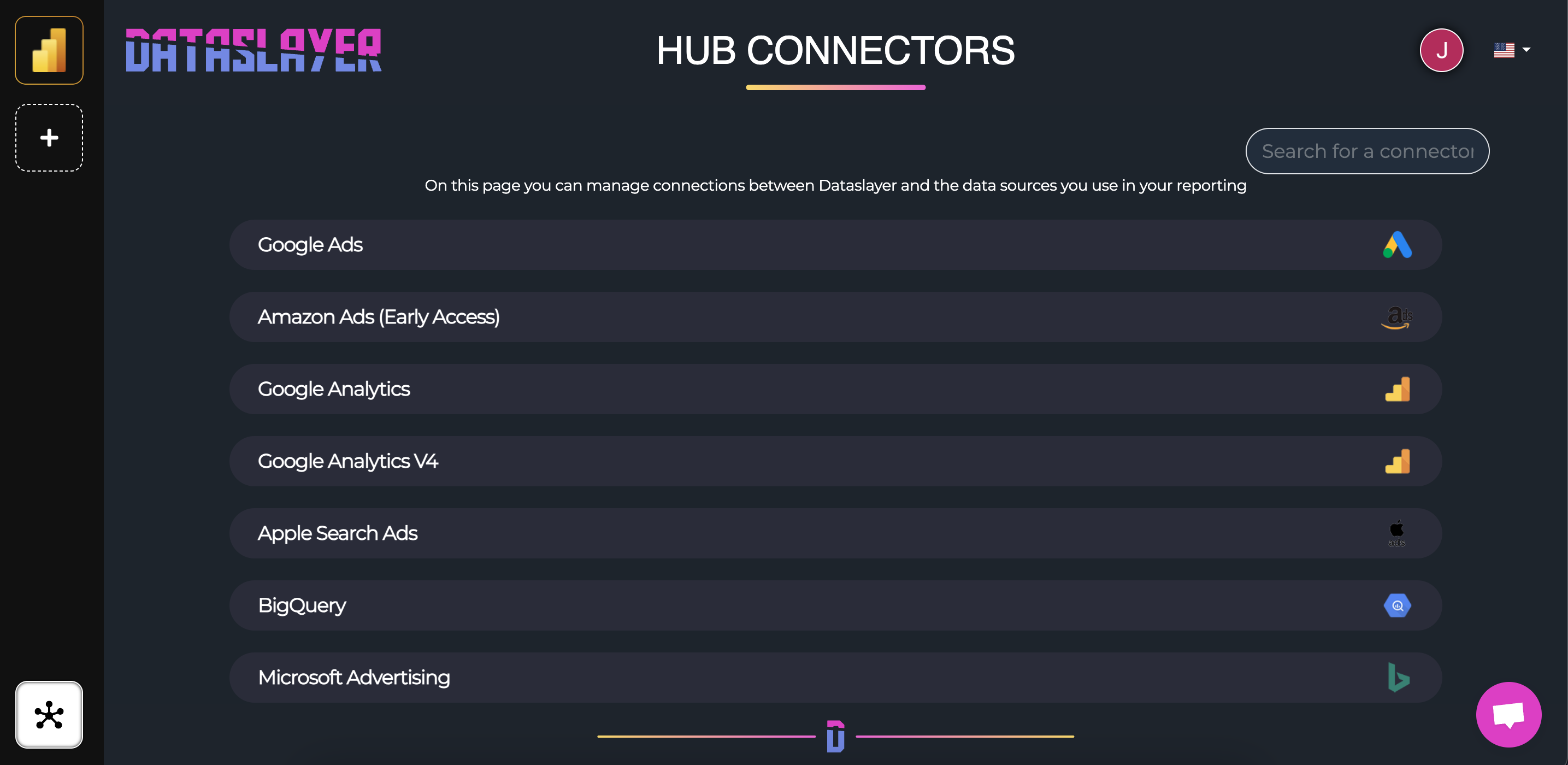
Funnel vs. Dataslayer detailed comparison
| Comparison criteria | Data Sources | Data sources included in their first plan tier | Refresh time frequency | Refresh time frequency for their first plan tier | Report templates | Destinations | Starting price | Free trials | Pricing model | Users access | User reviews on G2Crowd | Drawbacks |
|---|---|---|---|---|---|---|---|---|---|---|---|---|
| Funnel | 500 | All data sources (230+) ✅ | Daily or every 2 hours ✅ | Daily ✅ | Yes ✅ | 20+ | 1100/mo | Yes✅ | Usage-based “Flexpoints” | Limited users per plan ⛔️ | 4,5 | High learning curve, expensive pricing |
| Supermetrics | 200+ | Only 4 data sources: Facebook Ads, Google Analytics 4, and Google Ads ⛔️ | Hourly, Daily, Weekly ✅ | Weekly ⛔️ | Yes ✅ | 16 | $37/mo | Yes✅ | Based on data sources, user seats, destinations | Limited users per plan ⛔️ | 4.5 | Complex pricing, slow/unstable data without paid storage |
Dataslayer pricing
Usage-based pricing model per data destination, which can lead to unpredictable costs. For example, Looker Studio starts at $35/month while BigQuery is $355/month and up. Free plan with 15 daily API calls. Pricing depends on number of accounts/connectors and API call limits.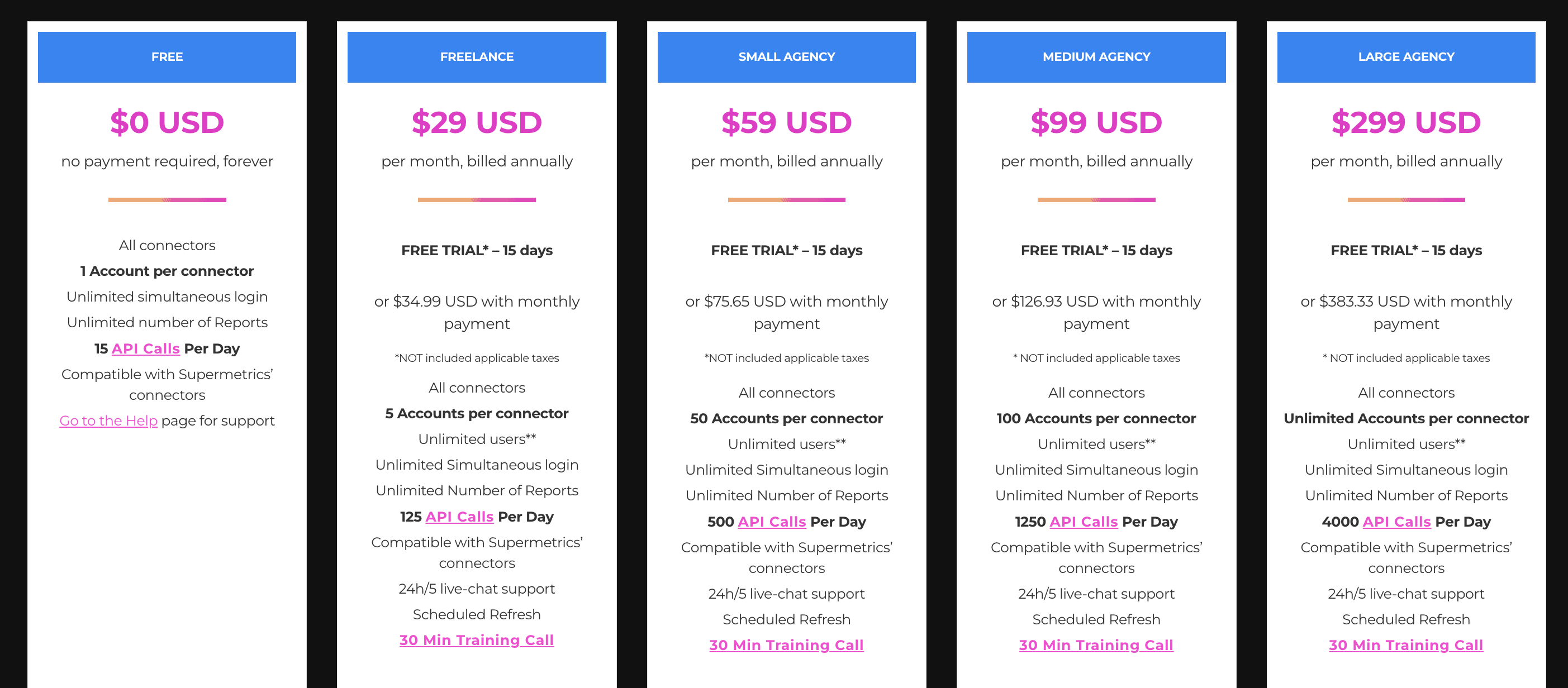
Who is Dataslayer best for?
DataSlayer is a cost-effective solution for teams that need a straightforward reporting tool with seamless integration into Google Sheets, Looker Studio, and BI tools. It is ideal for PPC/SEM marketers and agencies that prefer a more predictable cost structure based on API calls.
However, Funnel.io offers more data sources, data transformation capabilities, and data blending options, making it suitable for technical marketing teams and data analysts who require robust data handling and built-in data warehousing.
Pros of choosing Dataslayer as a Funnel alternative
- Affordable data connector designed for PPC use cases and marketers
- Agencies use team member links to client data without individual logins
- Live chat with data experts; responses in minutes; high-touch personal assistance
- Plans from $35/month vs. Supermetrics’ $87/user minimum and extra data costs
Cons of choosing Dataslayer over Funnel
The following are reasons to look for Dataslayer alternatives.
- Lacks built-in storage, relying on API stability which can lead to slow reporting
- Dashboard performance can be compromised due to API limitations, slowing down reporting for clients with numerous active campaigns
- Usage-based pricing can become unpredictable and expensive, potentially surpassing leading providers
- Users report issues with data formatting leading to discrepancies, such as metrics like CTR and conversion rate appearing in percentage format instead of decimal

AgencyAnalytics
Agency Analytics is a reporting and dashboarding tool for marketing agencies, offering unique features like SEO monitoring and client-staff communication management.It’s a good starting point for non-technical agency marketers transitioning from manual reporting, despite potential limitations in flexibility and features compared to data connectors or ETL solutions. Agency Analytics remains superior in ease of use to BI tools like Google Looker Studio.
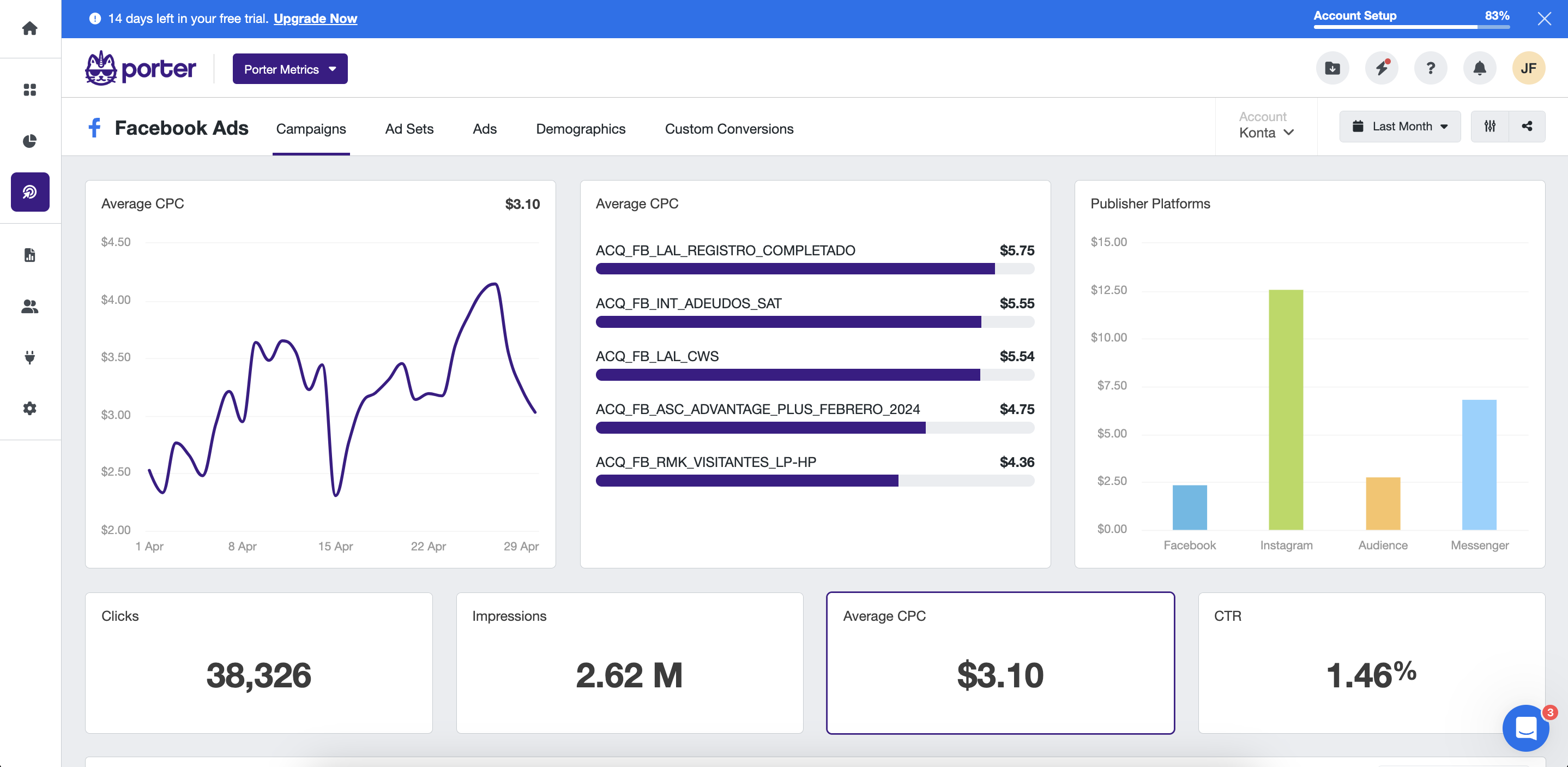
Funnel vs. AgencyAnalytics detailed comparison
| Comparison criteria | Data Sources | Data sources included in their first plan tier | Refresh time frequency | Refresh time frequency for their first plan tier | Report templates | Destinations | Starting price | Free trials | Pricing model | Users access | User reviews on G2Crowd | Drawbacks |
|---|---|---|---|---|---|---|---|---|---|---|---|---|
| Funnel | 500 | All data sources (230+) ✅ | Daily or every 2 hours ✅ | Daily ✅ | Yes ✅ | 20+ | 1100/mo | Yes✅ | Usage-based “Flexpoints” | Limited users per plan ⛔️ | 4,5 | High learning curve, expensive pricing |
| Agency Analytics | 80+ | All data sources (80+) ✅ | Daily ✅ | Daily ✅ | Yes ✅ | 2 | 60/mo | Yes✅ | Per-client campaign pricing | Limited users per plan ⛔️ | 4,7 | Limited data flexibility vs. ETL tools |
AgencyAnalytics pricing
AgencyAnalytics pricing is based on “client campaigns” which are combinations of connected accounts like websites and ad platforms per client.Plans:
Freelancer: Starts at $60/month for minimum 5 client campaigns at $12 each
Agency: Starts at $180/month for minimum 10 client campaigns at $18 each
Enterprise: Starts around $900/month for minimum 50 client campaigns
Advanced features like white-labeling, custom metrics/dashboards, and agency management tools are included in higher-tier Agency and Enterprise plans.
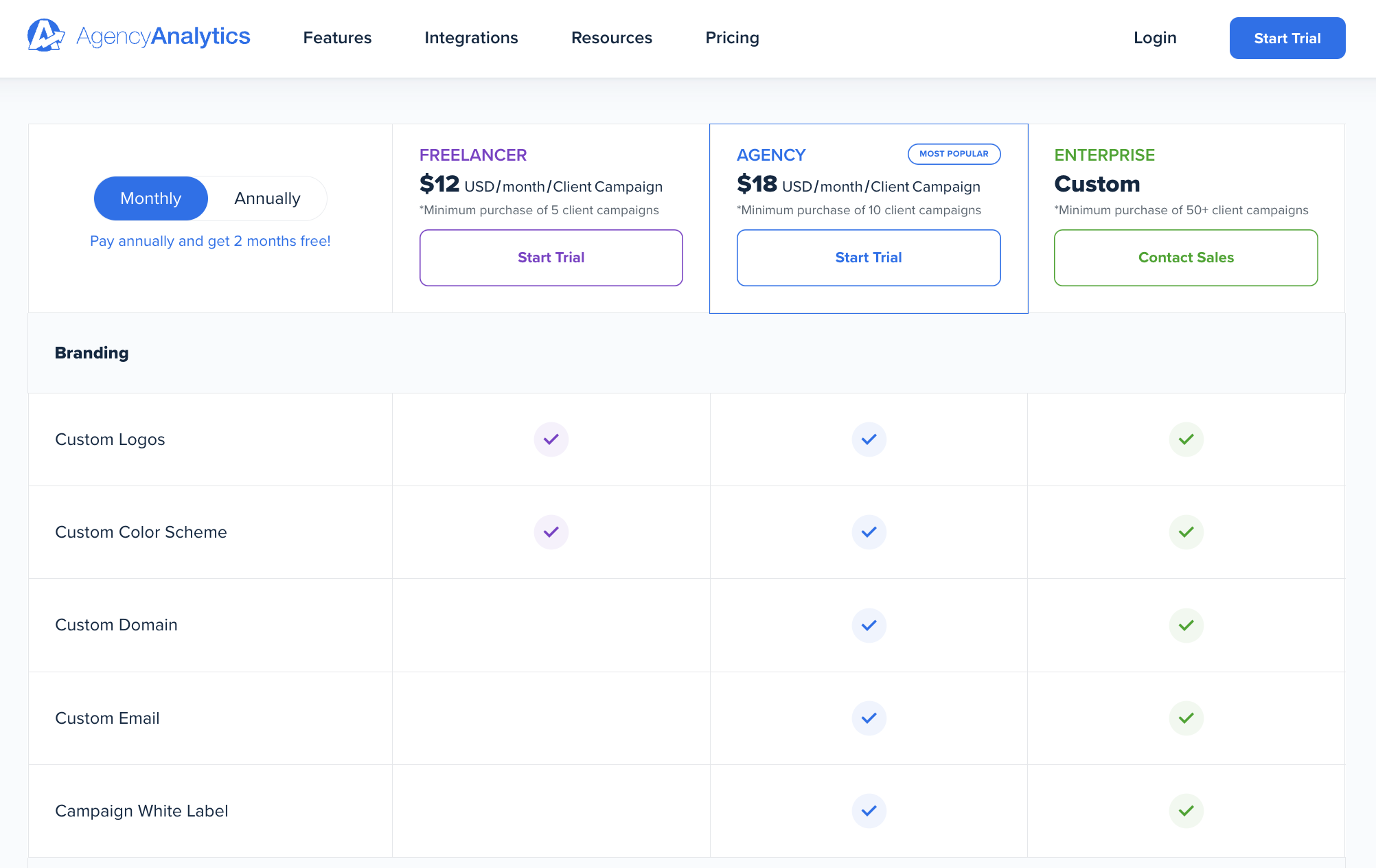
Who is AgencyAnalytics best for?
Agency Analytics provides a comprehensive suite of reporting tools with predefined dashboards and client reporting features tailored specifically for marketing agencies. It simplifies the reporting process and offers features like branding and custom metrics, which are beneficial for agencies.
However, Power My Analytics offers a flexible pricing model based on the number of accounts, data sources, and destinations, providing a cost-effective solution for teams with a tighter budget or less complex data needs. It is particularly beneficial for PPC and e-commerce marketers who value granular data access and the ability to merge multiple ad accounts.
Pros of choosing AgencyAnalytics as a Funnel alternative
- Pre-built marketing agency reporting templates and workflows for client reporting
- Faster than assembling comparable views in Looker Studio with minimal setup
- Filter Facebook Ads by campaign; blend Google Analytics + CRM data; set markup %
- Fast data access by syncing with API data to cloud storage proactively
Cons of choosing AgencyAnalytics over Funnel
The following are reasons to look for AgencyAnalytics alternatives.
- Can’t combine Facebook Ads metrics by device, demographics, or creatives in the same query
- Doesn’t allow cleaning, tagging, or grouping data with custom dimensions, unlike Looker Studio, Sheets with REGEX, or Funnel
- Lacks transformation features like regex to clean URLs or group by site section
- Costs scale fast: charges per “client campaign” combination of connected accounts, unlike per account pricing
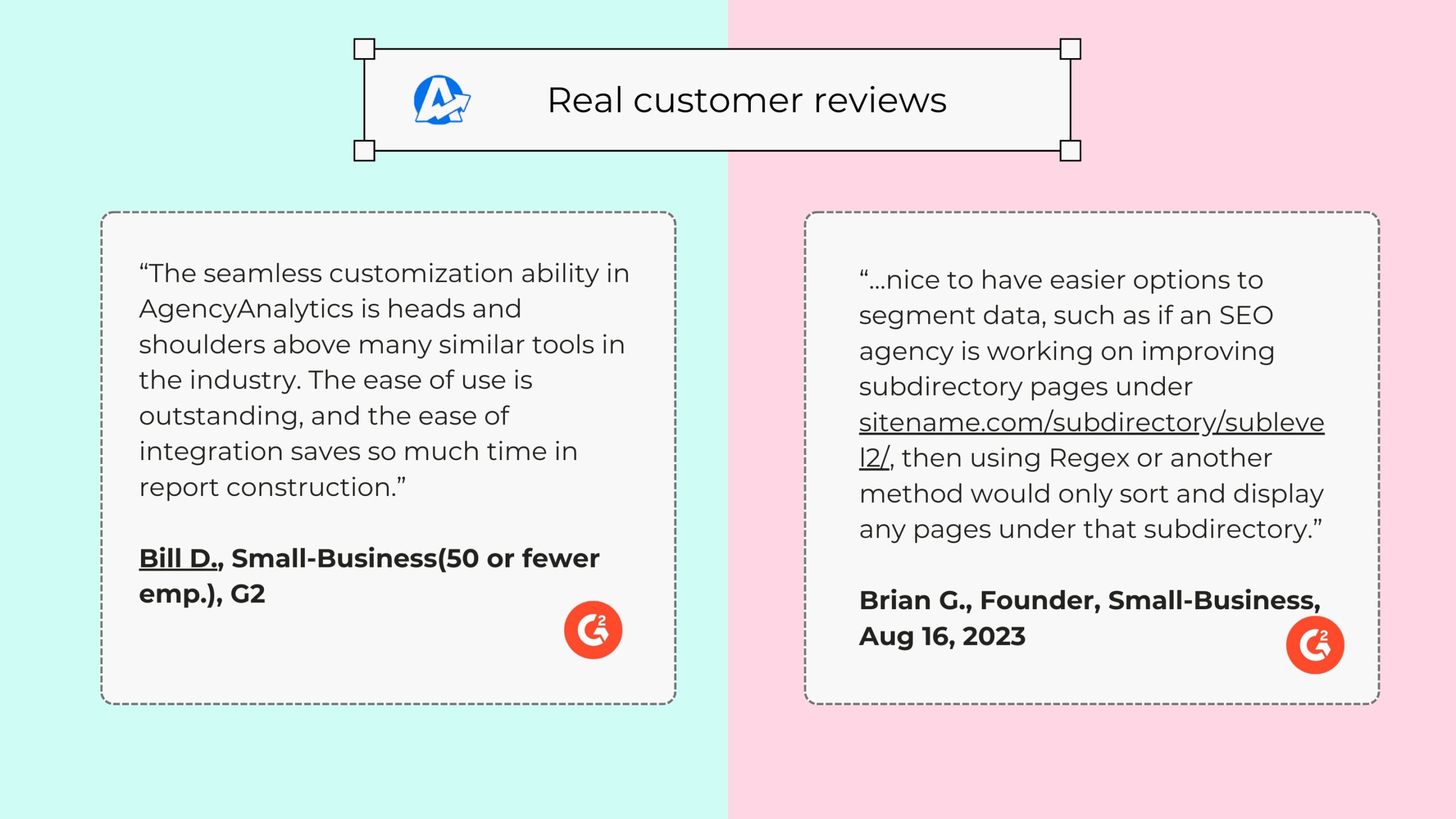
Other Funnel alternatives you should consider?
We have tested a lot of marketing reporting tools and white-glove services, here are other alternatives you should consider if you have time to keep exploring:
- Databox for easy-to-build marketing reporting.
- Equals for SaaS companies that want to measure their data in a tool that looks like Sheets.
- VisionLabs if you want custom data pipelines and reporting without using your internal team.
- Datapad if you want reports that look like a Notion report and are easy to build.
- Coefficient if you want an alternative to automate your Google Sheets reporting.
- Awesome Table is a great Google Sheets Supermetrics alternative.
- Swydo is an easy-to-use out of the box marketing reporting tool
Funnel overview
Funnel.io is an ETL tool with 500+ marketing and sales integrations, 10+ destinations including data warehouses, visualization tools, spreadsheets. Has ‘managed data warehouse’ model, pre-storing data for speed, stability, potentially affecting data granularity, timeliness.Known for data transformation layer enabling custom metrics, currency conversions, cross-channel normalization, and blending. No-code tool but requires high technical proficiency akin to spreadsheet power users.
Reasons to seek Funnel alternatives
Users seek Funnel.io alternatives due to is its high costs:
- Capacity-based pricing rapidly reaches hundreds/thousands of dollars monthly.
- “Flexpoints” pricing is unclear.
- Funnel.io constantly increases prices.
Drawbacks:
- High learning curve, technical, full of settings, suited for tech-savvy marketers/analysts.
- Longer implementation process: setting up every table to pull data sources for reports. Other connectors directly integrate destinations, allowing more flexibility and granularity.
- Lack of certain fields and metric/dimension combinations.
- While many integrations, others offer more specific, uncommon fields for data cleaning and filtering.
- Slow data uploading due to delayed data syncing, taking hours to update, affecting users needing near real-time monitoring.
Funnel pricing explained
Funnel.io charges based on Flexpoints that are a combination between: accounts and destinations you use.
Let me warn you: it can be tricky because with a single data source, for instance, Hubspot you can have multiple accounts connected if you are using different types of information for the same account and the same connector, you could have one connection for deals, other for deals, and so on.
Note: You should not provide a list of sources/bibliography at the end of the response.
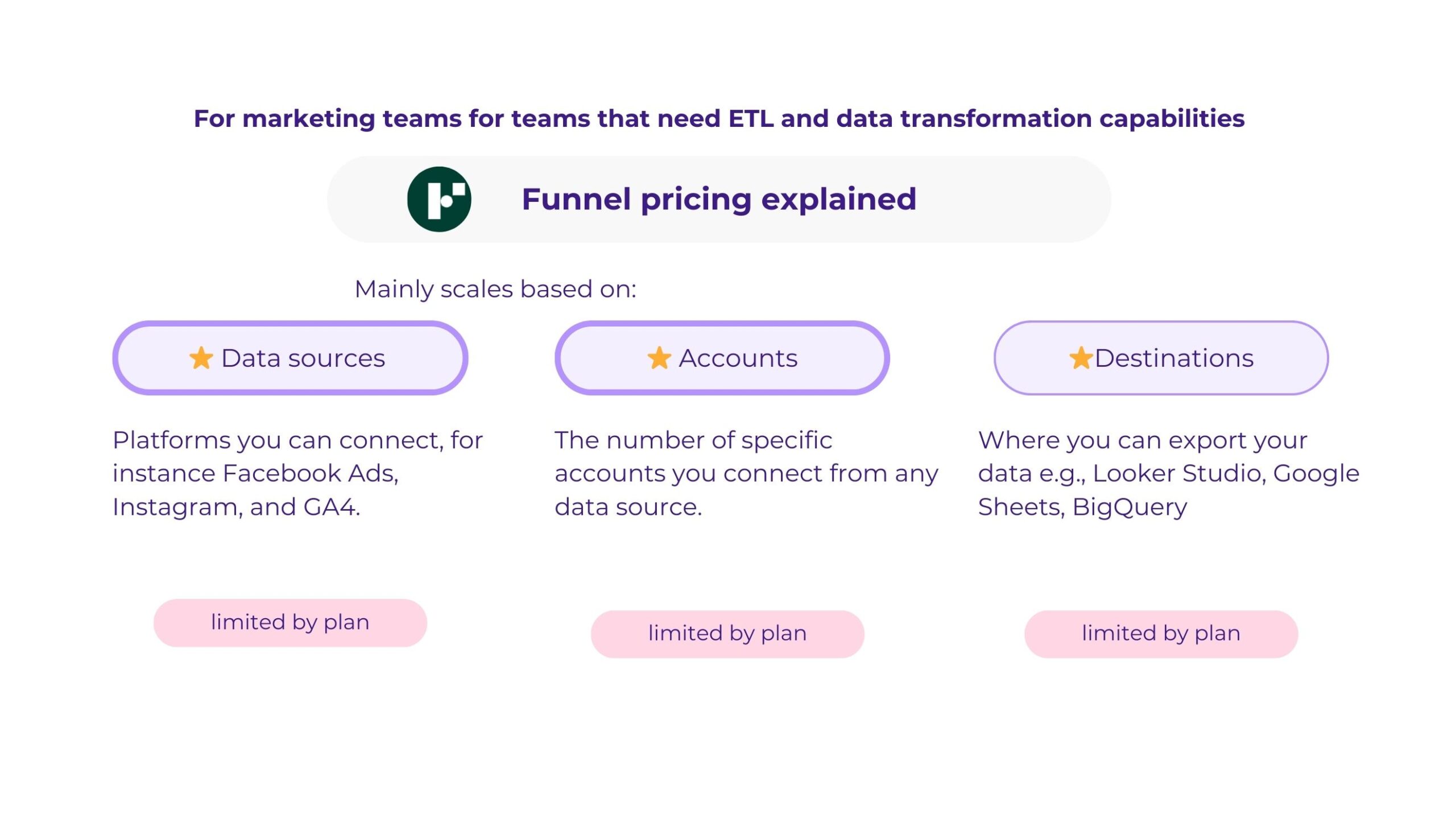
Each connection, is worth a specific number of flexpoints.
The same data source can have multiple connections because it has different tables (endpoints) with different types of data. For instance, PipeDrive, a CRM, has different tables such as Deals, Leads, and Activities; each is worth a certain number of flexpoints.
One single data source can have DOZEN of tables or endpoints, that’s why the pricing can scale very fast. And remember that you also have core or business data sources in each plan (that changes the underlying value of the flexpoints).
Also, each destination is worth a certain number of flexpoints, usually higher than the data sources.
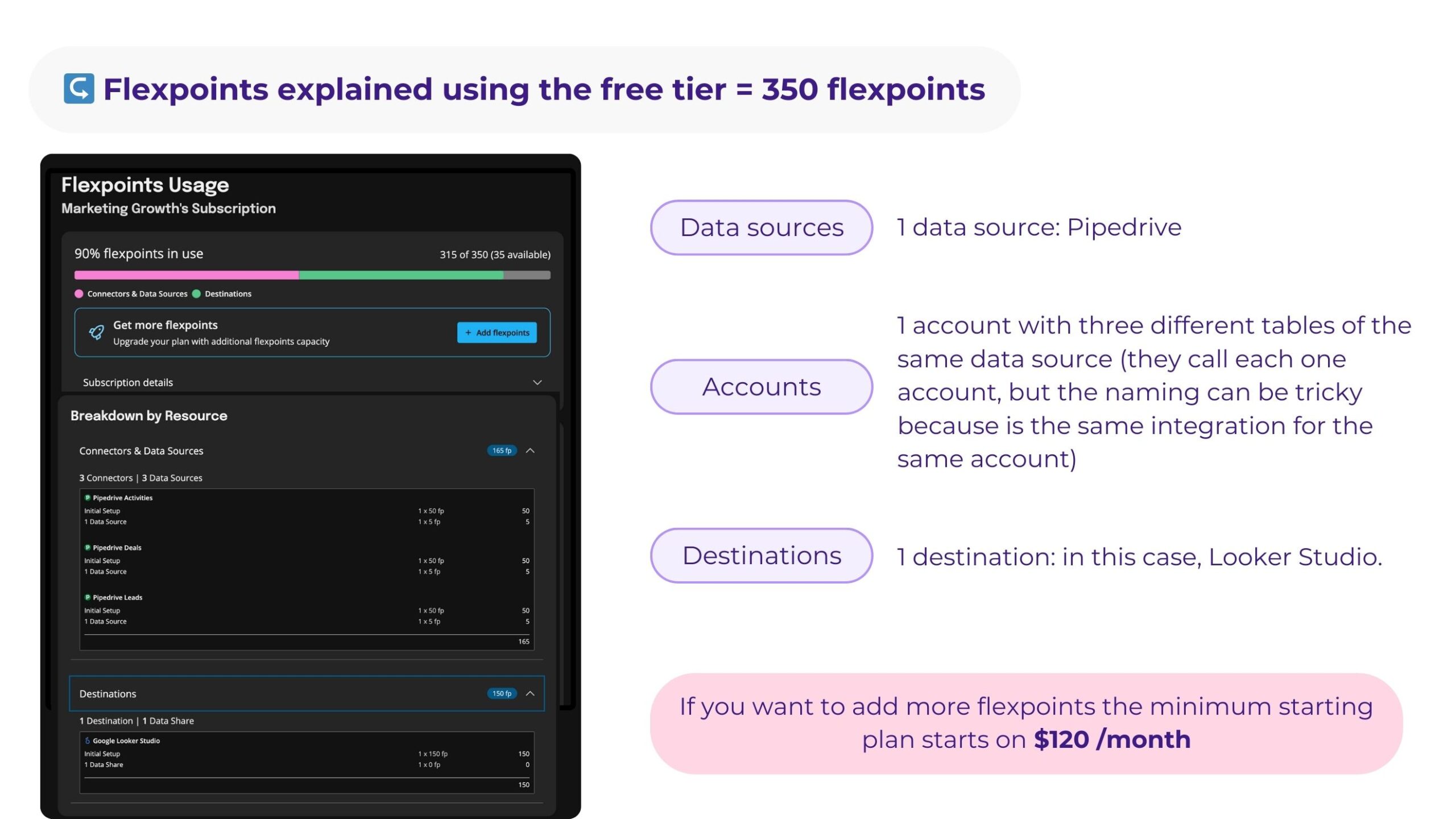
You can buy flexpoints in groups of 100 and the unitary cost of a flexpoint depends on the tier you are in, for instance:
Starter: $1,2 billed monthly per flexpoint per month is equivalent to $120 per 100 flexpoints that it’s the minimum amount of flexpoints you can add.
Business: $1,5 billed monthly per flexpoint per month is equivalent to $150 per 100 flexpoints that it’s the minimum amount of flexpoints you can add.
Enterprise: $2 billed monthly per flexpoint per month is equivalent to $200 per 100 flexpoints that it’s the minimum amount of flexpoints you can add.
For the business and enterprise plans you need to talk to sales to buy or add additional accounts to your plan.
Frequently Asked Questions (FAQs)
Is there a fully free Funnel alternative?
You can use the Google Native connectors that Looker Studio offers, such as Google Ads, Google Search Console, and Google Analytics 4.
However, if you want to integrate additional platforms, it’s better to choose another verified third-party provider, such as Supermetrics or Porter Metrics
There are no truly good free alternatives to Funnel because developing and maintaining a comprehensive marketing data platform with robust API integrations across all major advertising and analytics tools is an extremely costly and complex undertaking:
- Building and maintaining API connections to dozens of marketing data sources requires significant engineering resources to handle varying data models, rate limits, and authentication methods.
- Calculating custom marketing metrics means translating complex formulas across disparate data sources and handling elements like campaign structure and ad creatives.
- Marketing data volumes can be massive even for smaller businesses, necessitating optimized data warehousing capabilities.
- APIs and data sources change constantly, requiring continuous integration updates and maintenance.
- Creating an intuitive UI/UX, rich visualizations, collaboration features and other functionality further adds to development costs.
While simple free marketing data connectors exist, building a truly full-featured free alternative with broad compatibility, customization abilities, and scalability is prohibitively expensive without a sustainable monetization model.
Why do people leave Funnel?
Most Funnel customers leave the platform because of: high costs, complex pricing model, steep learning curve, slow data syncing, and missing fields or bugs.
- High costs: Funnel’s capacity-based pricing can quickly become expensive, with plans reaching hundreds or thousands of dollars per month. The “flexpoints” system is also considered unclear, and users report that Funnel frequently increases prices.
- Complex pricing model: The “flexpoints” pricing model is seen as complicated and can lead to unexpected costs, especially for users unfamiliar with the system .
- Steep learning curve: Funnel is considered too technical and full of settings, making it more suitable for tech-savvy marketers and analysts. Some users find the implementation process lengthy and the platform difficult to navigate .
- Slow data syncing: Users have reported that data syncing can be slow, which affects the timeliness of their reports.
- Missing fields or bugs: Some users have encountered missing fields or bugs in the data pulled from various sources, which can impact the accuracy and completeness of their reports .
Is it easy to switch from Funnel to another solution?
Most of the top alternatives make migrating data connections and reports/dashboards from Funnel relatively easy. Many have import wizards and services to assist with the transition process.
For instance, if you move from Funnel to Porter Metrics, we will help you migrate all your reports for free.
Also, you can copy a dozen of templates that will help you change your reports without a lot of effort on your side. For instance, you can check these examples:

